St. Thomas More College’s liberal arts journal since 1995

Vol. 27, No. 1 March 2023
The “Horizon” Issue
ASSOCIATE EDITOR
Jenna Roesch
FICTION EDITOR
Toni Safinuk
NONFICTION EDITOR
Rahul Edwin
POETRY EDITOR
Alexandra Currie
VISUAL ART EDITOR
Namya Jain
LAYOUT & DESIGN EDITOR
Emily Zbaraschuk
EVENTS MANAGER
Jamen Willis
COMMUNICATIONS MANAGER
Abena Amankwah-Poku
VISUAL ARTS TEAM
Basisah Musarrat
Abena Amankwo-Poku
STAFF ADVISOR
Linda Huard
FACULTY ADVISOR
Dr. Hannah Wood
The views expressed in this publication do not necessarily represent those of the in medias res editorial board. Individual copyrights belong to the contributors. Illustrations are created by the Visual Arts Team.
Contact Us
inmediasres@stmcollege.ca
EDITOR’S NOTE
Dear Readers:
It is with great pleasure that we present to you the latest issue of our journal, featuring an array of thought-provoking and evocative works which explore the fascinating theme of horizon. This issue showcases a diverse selection of poetry, visual art, fiction, and nonfiction, from our USask community of undergraduates, graduates, staff and alumni, who all explore the different aspects of this powerful and elusive concept.
The horizon has long been a source of inspiration for artists and thinkers across cultures and throughout history. It represents a boundary between the known and the unknown, the familiar and the unfamiliar, and the possible and the impossible. It is both a physical and metaphysical concept, inviting us to consider the limits of our perception and imagination, as well as the vastness of the world and the universe that lies beyond.
In this issue, our contributors have taken up the challenge of exploring the many meanings and interpretations of the horizon, from the beauty of possibility to the fear of the unknown. Through their work, they invite us to consider the horizon as a symbol of hope, a marker of progress, and a source of inspiration. They also explore the darker side of horizon, highlighting the barriers and limitations it can impose, and the feelings of frustration, anxiety and uncertainty that can arise from confronting it. Through their creative expressions, our contributors also challenge us to explore our relationship with the horizon and how it shapes our perspectives and aspirations.
We are thrilled to share this inspiring collection of works with you from ‘the Land of the Living Skies’, and we hope that they will invoke your imagination and spark meaningful conversations about the horizon and its significance in our lives.
Sincerely,
Jenna Roesch Associate Editor 2022/2023
1 / in medias res EDITORIAL BOARD
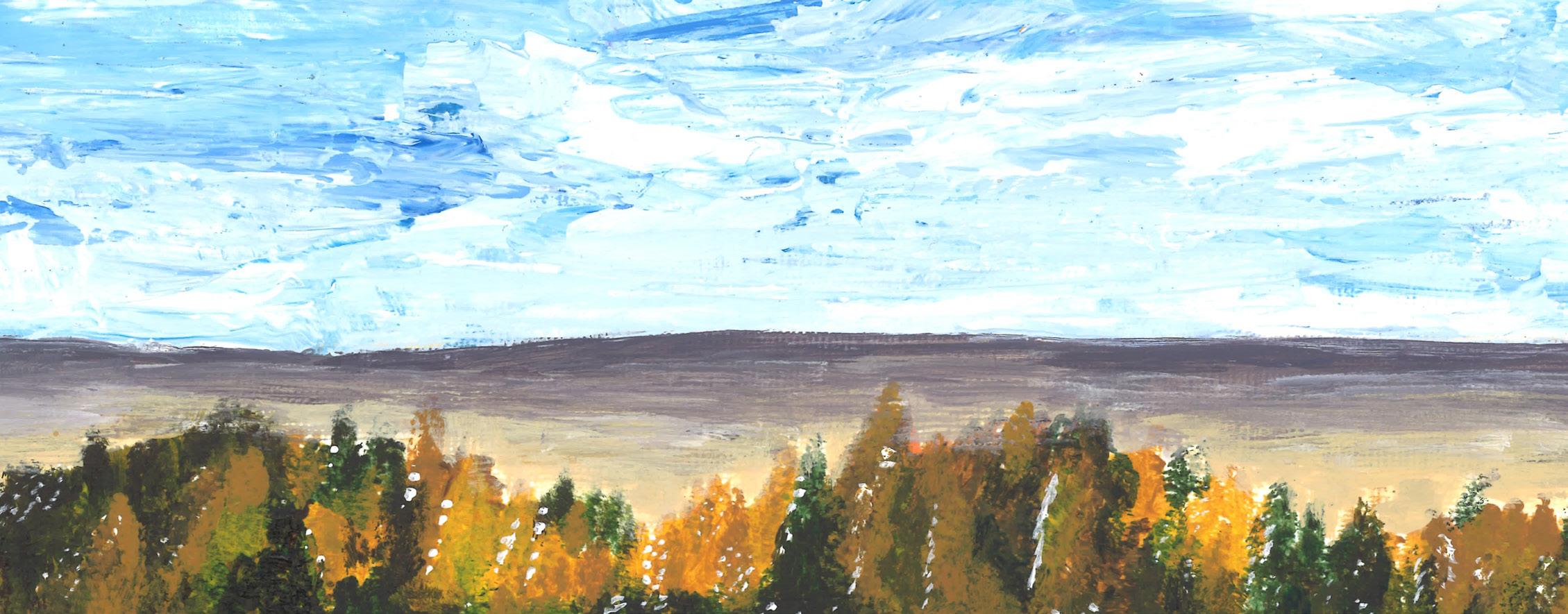
“horizon” / 2 CONTENTS Poetry 10 14/02 34 Airplanes 22 At the Trial of God, You Will Meet Your Body 16 The Cold Welcomed Me and I Embraced It 34 Discernment 28 Dreamers 28 Faith 06 finding horizons mine // the edge of my earth 20 Home is Where the Sun Sets 10 Horizons of Life 12 In the Partial Shade 03 January Hands 33 The Painting 14 Rigby 05 (seconds for st romero) 27 Transience 21 whatever it was it was and it is not it now 04 Winter in Saskatchewan 15 your mother and i have the same hands Nonfiction 11 A Letter to my Anecdotal Self 24 Once They Were Children 29 Pro et Contra: AI Technology 07 A Step Closer to the Undefined Fiction 17 Dangerously Below the Horizon Visual Art 25 Before the Night 21 Before the Storm 33 Beyond 09 Beyond the Horizon 32 Beyond the Wall 03 Choose to Heal, Choose to Change 27 Dream Beyond the Moon and Stars 13 Dream of Tomorrow 32 Horizon 35 Horizons Painting Event 08 Let Me Live 31 Long Summer Drives Across the Prairies 13 An Ode to Borscht 08 Out into the Distance 23 Peace on the Horizon 04 Polar Bear 15 Reach 12 A Saskatchewan Landscape 06 The View Contributors 36 Contributor Bios
January Hands
Bailey Schaan
Fingertips white, dusted in the finest layer of frost chapped and cracked and dry. Miniscule fragments of papercuts, hairline fractures forming fissures so fine you must peer close to see.
These are embers burning under my nail beds. They are blue fading into fleshy pink like the sky when the sun dips below the horizon at the unripe hour of five pm.
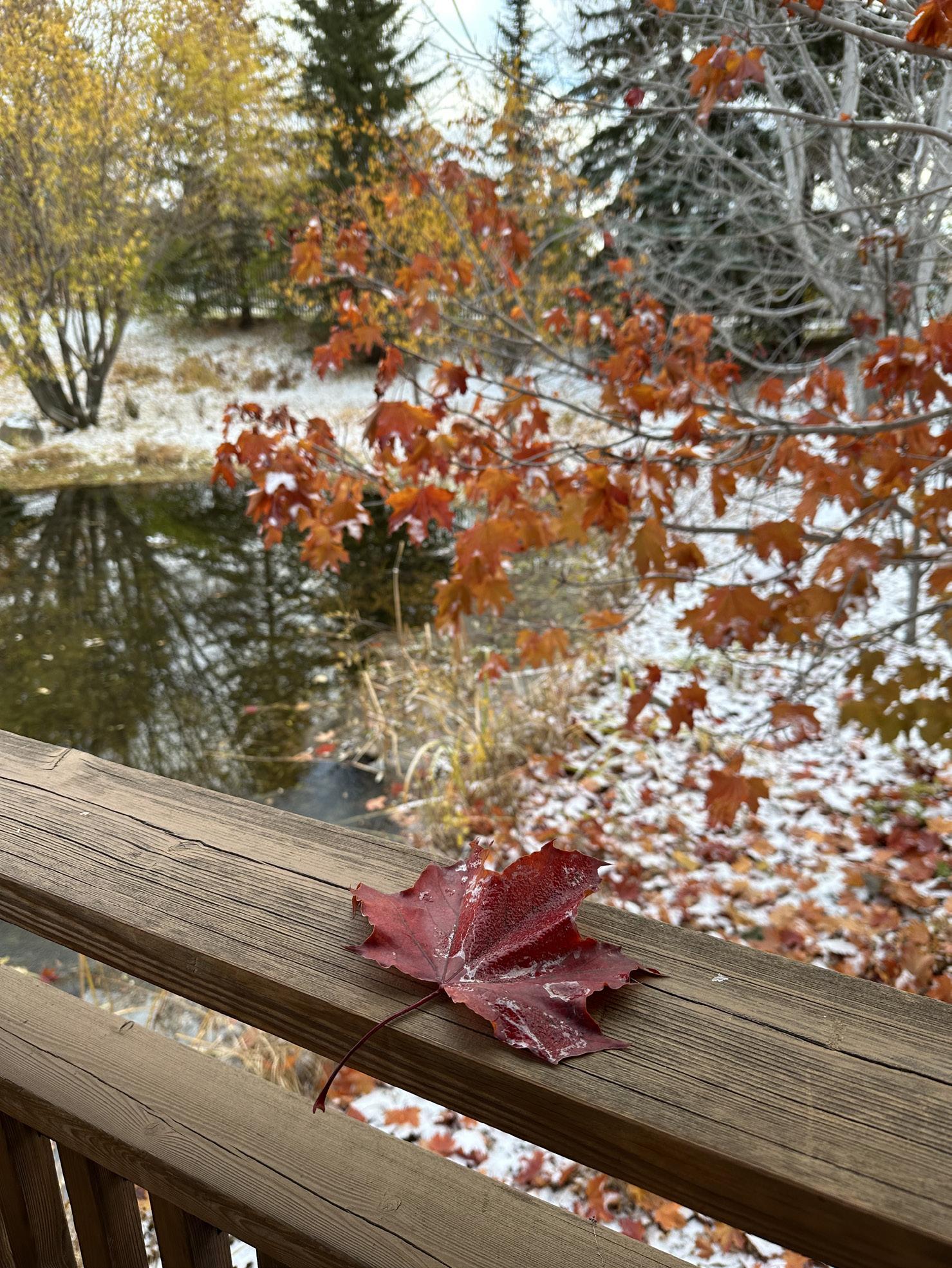
Choose to Heal, Choose to Change by ASMA KAMEL
Photography
Every year, the colourful autumn leaves carry a message from nature to embrace the change and let it flow. Change is a natural cycle that we are a part of, which is why we should widen our perspectives and accept it, as with every change comes the opportunity to heal and flourish.
* Previously published on Instagram @peerhealthusask. It won first place in the category of self-care and mental health in the 2nd Annual Photo Contest.
3 / in medias res POETRY
Winter in Saskatchewan
Cynthia Wallace
Joy is the sky when we reach the park on any given morning’s walk to school, and it opens out to prairie-wide dovegrey blue and almost-light—
and I know we’re going to have day again. I mean, I know the sun is on its way, even after another night so long I lost my shadow in it.
The kids run from a friendly dog, unaccountably afraid, and I want to say to them: not everything is safe, but don’t stop watching the horizon for the hope.
And listen to the trees. They tell the truth of rising anyway.
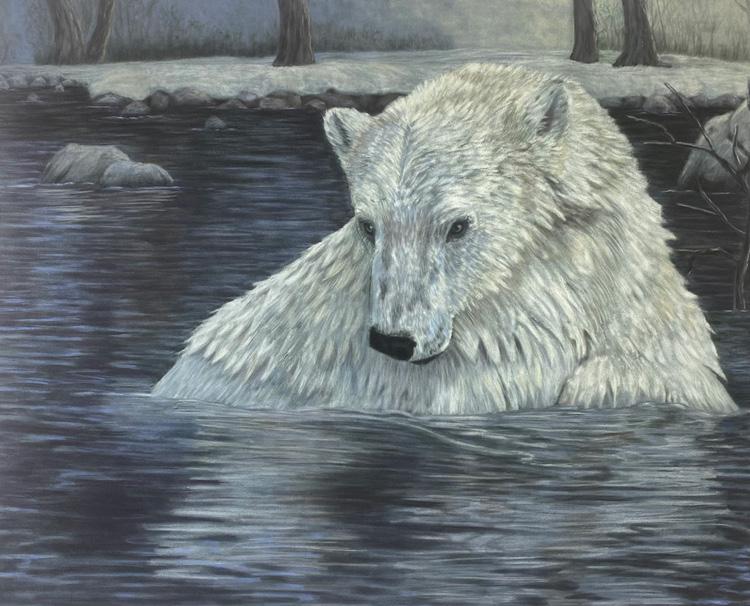
“Polar Bear” was inspired by Rea’s time during her artist residency at the Saskatoon Forestry Farm Park and Zoo. This piece represents the urgency of climate change and the continued need for action. Rea hopes viewers are reminded of our interconnectedness with nature and the importance of preserving animal habitats.
“horizon” / 4 POETRY
Polar Bear by KAS REA Chalk pastel on green velvet

(seconds for st romero)
Mike Sluchinski
specified time of action set now and forever and amen
(gunfire/sounds of danger abound)
our private martyr romero all the time all the time in the all the time and seconds
line not pile not stack not rail not hang not spain not rest not push not span not deep note break
lean not pass not stow not trail not lift not drop not stash not place not put not handle with not
nest and nestle not lever not set not aside not deep note break
right beside not next to next too on at not under over on top of sometimes with a thigh draped over not heel to toe not
no not there here no there there and there and there down and around again not next to next too next too
put the book down
romeros moments no doubts not not not (gunfire/sounds of danger abound)
5 / in medias res POETRY
finding horizon mine// the edge of my earth
Ji Hyun Chan
travel as we do open skies above will still see the “same same” sun for as long as you can see And the light splinters seas of golden wheat
further out go to see we swimming clouds are passing by much brighter it seems to be never in one place the earth
as the sun comes up hearts take flight above she gives everything its shape much further than you can see and the light gathers flying past the wheat
so far as the eyes can see passing the flat line by by new horizons to be found to fall off the edge my earth
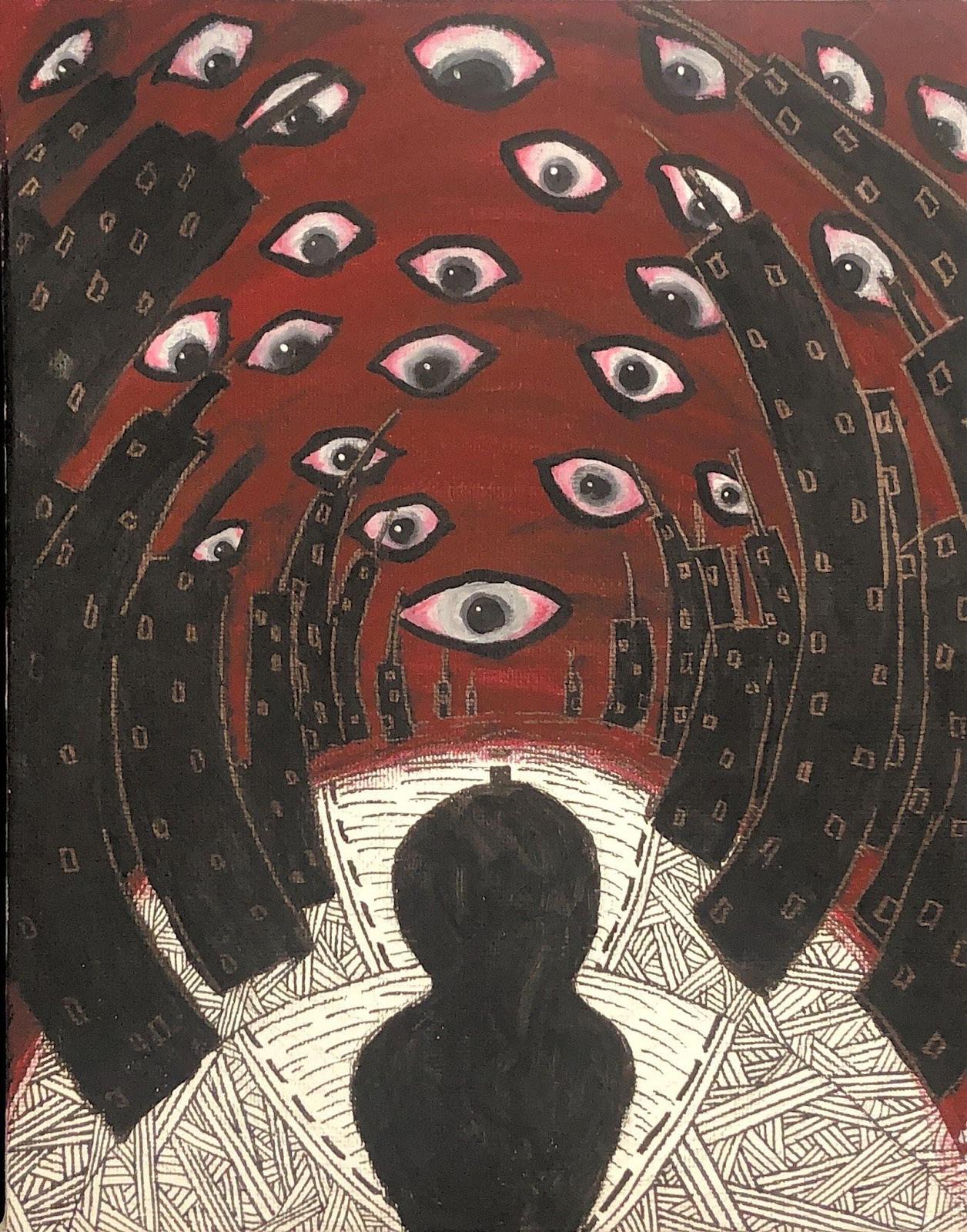
When one gazes upon the horizon, it would most often be a beautiful sight to be seen especially in the Land of the Living Skies. In this work I tried to flip the situation around; while we are gazing at the sky, admiring its beauty, the sky is staring back and it’s staring with contempt. I believe I was trying to convey a Lovecraftian feeling of existentialism without fully realizing it, trying to portray the feeling of dread and the human insignificance in comparison to the vastness of whatever’s beyond the horizon.
“horizon” / 6 POETRY
The View by KURT CHAVEZ Paint and ink on canvas
A Step Closer to the Undefined
Mariana Campos Rivera
I never used to be worried about distances. I believed I could always go as far as I wanted, even if it was momentarily. I could go from the buried-in-cement lake where I grew up to see boats navigate the Baltic Sea. My job would take me to the Caribbean, the slopes of La Malinche, and the ice and salt-topped landscapes of Latin America. My hobbies would take me to psilocybin-full cabins where at a thousand meters above the sea, I could still listen to the ocean waves crashing as a lullaby, and then, they would take me to live on a socialist island.
So, I was not scared when I decided to move to the cold prairies. It was far but not that far…or at least that is what I told myself as I packed in my purple suitcase sweaters and jackets that would not do much for me during the Winter. And I’d be back. I
would. I kept telling myself that every time I felt the daylight was too short, the language was too hard, the academia was too white, and the money was too little. That helped because I discovered I could always bring myself back to where I belonged, no matter how long the distance was.
Little magic rituals would help me beat the distance. Sauteing tomatoes, white onion, and garlic, Hominy corn exploding in boiling water, looking at paintings of women having a beer, drinking blue cocktails you know you will regret having, thinking of hummingbirds, admiring the eyelashes of the cows. I had found these little pieces of myself outside of me, and they tried to keep me grounded, confirming that I was real, as if there were reassuring me that I existed not only in that moment but with all my history.
I believed that this technique would keep me safe from both the nostalgia that thinking of the familiar home created and from the uncertainty that the future inevitably brought to my anxious soul. Work, friends, family, my body, my mind. Everything is impacted by this duality of searching for myself somewhere else but feeling extremely rooted in things so abstract as a home, an identity, and memories.
But one day, I went back. And I did not find the familiar home. My identity was blurry, and the memories were contradictory. I found instead that places change, people die, babies are welcomed, jobs become dull, and inflation goes up. And everything I thought would be there was not. Nothing waited static for my return, and even in the day-to-day, the known setting showed itself as a myriad of foreign

NONFICTION 7 / in medias res
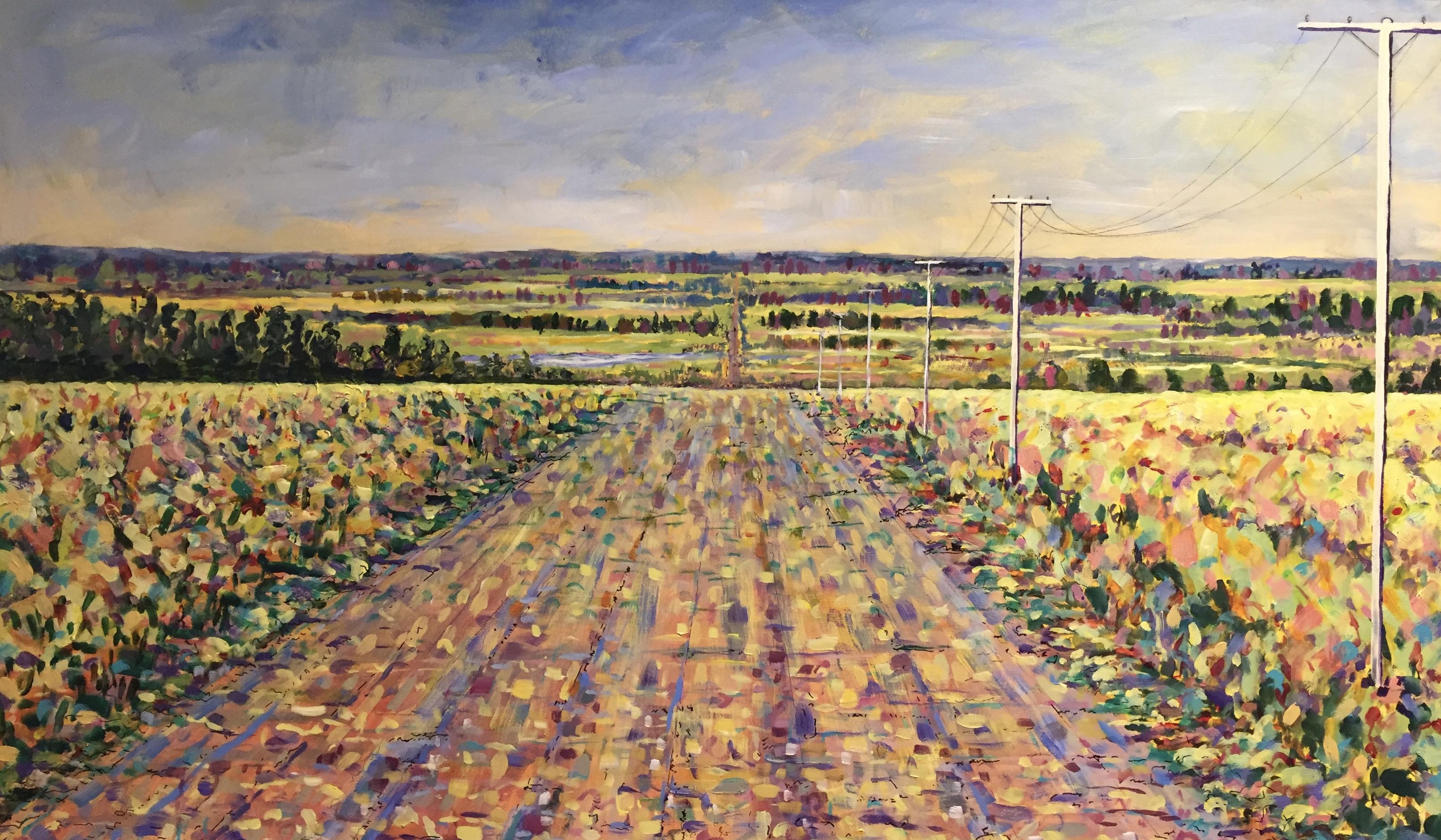
possibilities. I had changed too, and without noticing it too much, I started to gather in my soul new ways of being, new feelings, new ideas, new “MEs”. All were familiar and mysterious, reachable and abstract, here and nowhere. By moving, I created an infinite landscape around me, both my past and my future surrounding me in every direction. Memories, feelings, ideas, all so distant yet so intricately part of me. I have closed and I have opened venues. Even what was sure now seems unknown. All I can see now are clouds, the moon big in the sky to one side, the warm sun saying goodbye on the other, and in the middle, me, looking at them as if it was the first time ever. And it is only now when I feel the freedom of the living skies.
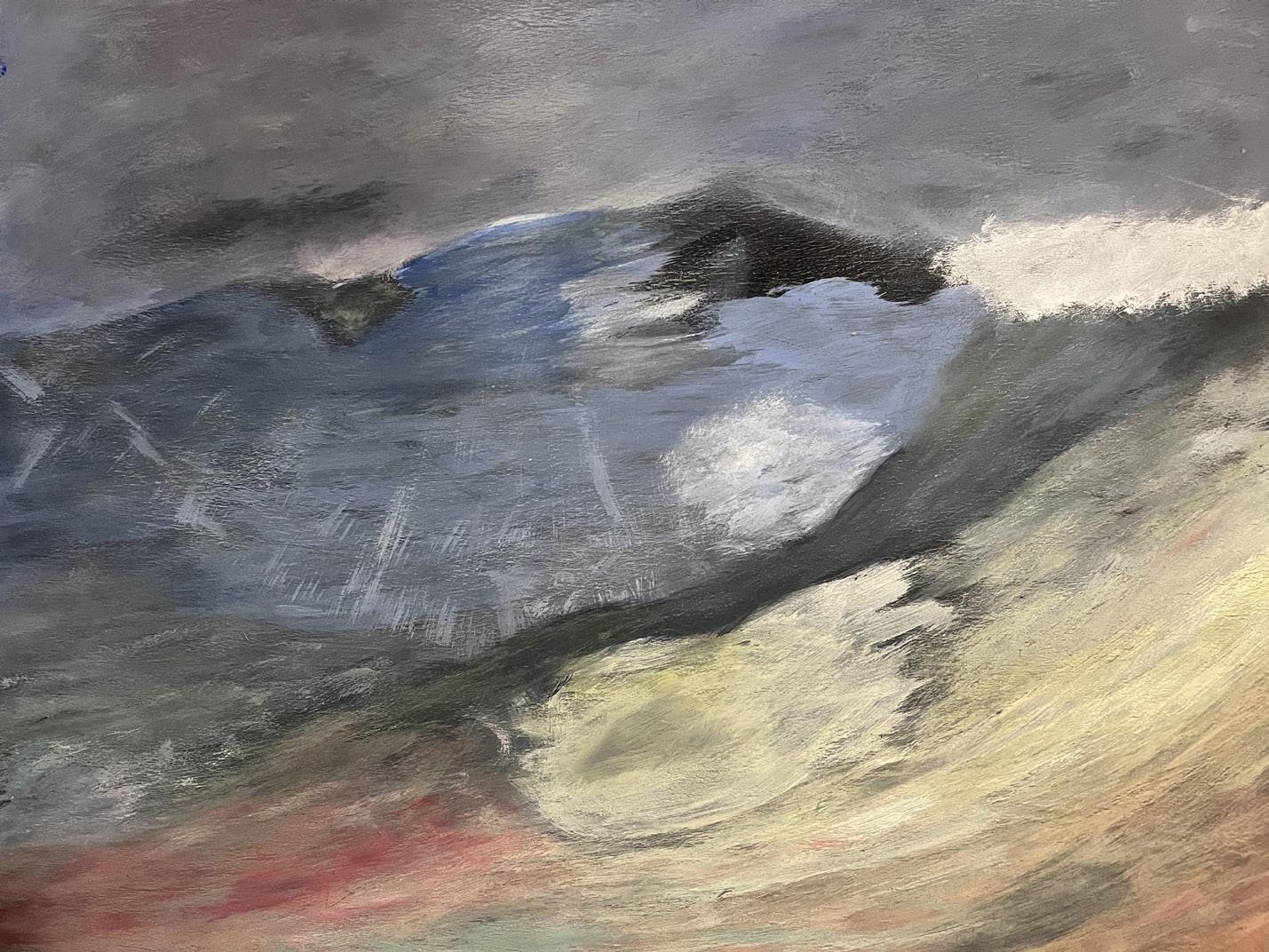
“horizon” / 8 VISUAL ART
Let Me Live by RACHEL JANZEN
Acrylic paint on a wood canvas
Out into the Distance by ANN B. DONALD Acrylic on canvas

9 / in medias res VISUAL ART
Beyond the Horizon by ANN B. DONALD
Acrylic on birch panel
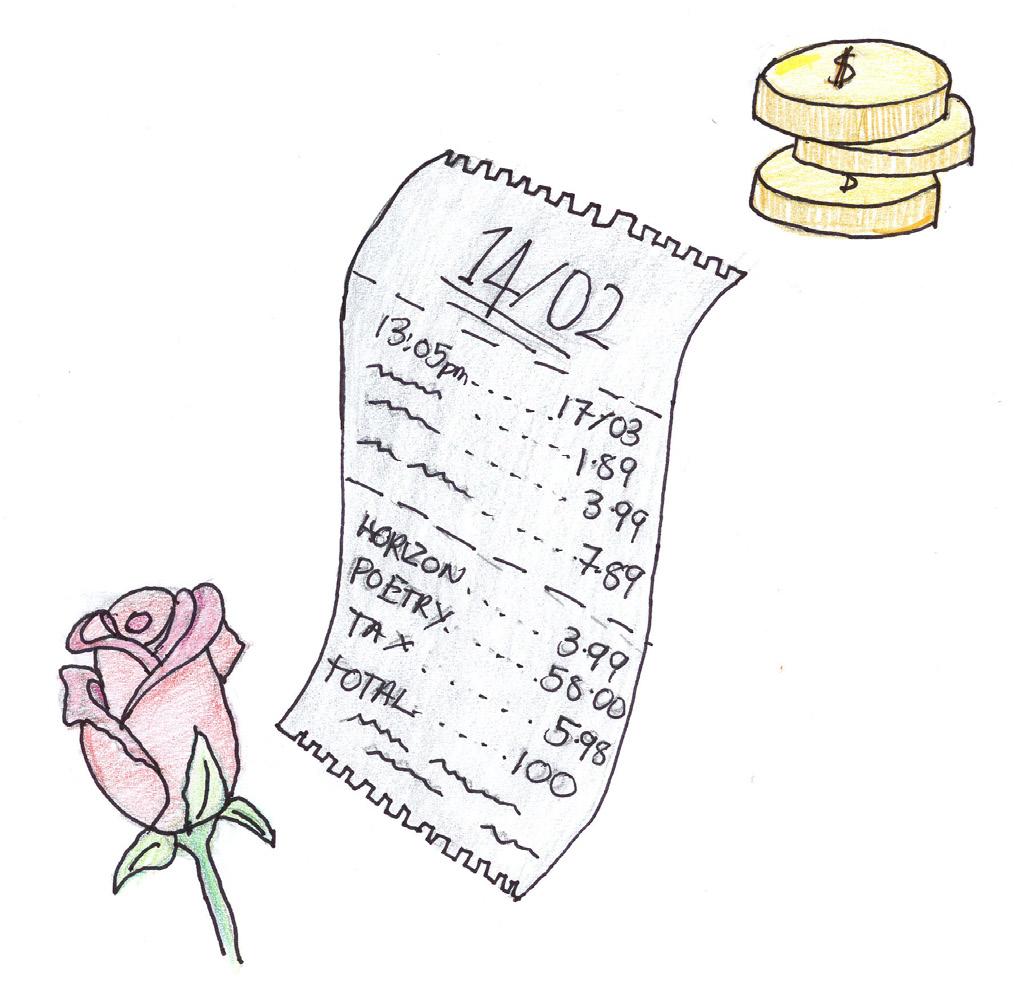
Horizons of Life
Anonymous
untethered and uninfluenced infant with starry, wide eyes endless horizon
curious and adventurous youth’s dream of a world at feet expanding horizons
cautious and bridled adult with accumulated experiences riveted horizons
sanguinely sage and accomplished old age of wisdom at peace compassed horizons
Unlock the fearless mind unfettered by stages, limitless the world, my oyster
14/02
Erin Gilbert*
faces & figures & farces font types sales font types contents
demander comment on rate comment on change
supplier
comment on attire comment on balance
comment on a joint chairs roses comment on a point six cent secrets
formation = flatter + fornication font type fade
demander & supplier blesser & abuser quitter.
* Instead of seeing the horizon as the line between land and sky, I chose to interpret it as the line between public, performative acts of love and the private, often precarious state of loving. “14/02” is completely bilingual with one half of the story represented in English and the other half in French.
“horizon” / 10 POETRY
A Letter to My Anecdotal Self
hoiyan
Last night, you wore long pants to bed. You haven’t done that since you were six years old. You complained to Mom about it being too uncomfortable during the night. The fabric that twisted and strangled your legs was a textural no-no, so you swore you’d only sleep in shorts from the age of six-and-a-half. You stuck with it until now. Did something throw off your rhythm?
Maybe it was the egg you burnt this morning. The kitchen filled with a light poof of smoke. You flinched in fear, waiting for the fire alarm’s ear-bleeding screech. You stared at your reflection on the electric stove surface, wondering if something was wrong with you. It was a ridiculous thought and an even more ridiculous reason to be upset, but you kept staring and kept thinking about how the child of an excellent chef should be able to cook perfectly—the child of a chef should be a perfect recipe. How dare you make mistakes as simple as that?
Maybe it was because of the creaky wooden kitchen chair you pulled out a little too hard last night and scratched the tiled floor. The decades-old dusty orange tiles became soot black in an instant. Who knew it was that easy to tarnish something. You tried rubbing the scratch away. You walked away with heavy steps and a black fingertip.
It could’ve been the cold glass of milk you poured into your hot chocolate last week. You’ve never liked your hot chocolate to be too hot or too chocolate-y. “Why would you drink hot chocolate if you don’t like chocolate or hot beverages?” people ask. Maybe it’s the way the white and brown intimately hug in the midst of a thermodynamic reaction. Maybe it’s because you love putting one hand on the near-scalding mug while the other grips the cool milk carton. You like the comfort of not having too much or too little of one thing. Maybe it’s the way the drinks curl into each other and form a planet around the mug’s rim. It reminds you of the few warm hugs Mom used to give only when you were shaking from the cold. In that brief moment, we formed our own planet. It felt alien—physical affection isn’t her strong suit, after all. You felt colder than outer space when she let go. If you poured 100 billion more cups, you could create your own galaxy. Is that why
we call it the Milky Way? No, of course that’s not the reason.
Maybe it was because you forced your friends into making friendship bracelets before they moved across the country half a year ago. You didn’t realize how much of your heart you could unravel and weave into such fragile embroidery thread. You attempted to cry silently when you got home and even used the knotted cord to muffle your sobs. The taste of blood flourished on your tongue. You didn’t want anyone to hear or see you being so weak.
Maybe it was because of that day, a year ago, when you were sitting in a “Mathematics for the Life Sciences” lecture. Scribbles and scratches came from every corner of the spacious hall. You ignored all the foreign and brain-melting concepts to focus on writing a classic iPhone Notes app poem. “I wasn’t supposed to be like this,” you titled it. When you stepped out of the lecture hall’s grand wooden door, you thought about what exactly prompted those words, and you’re still thinking about how those words came to be. They must have been bothering you for some time. Are they still dragging behind you on a thread?
Maybe it’s because of your attempt to call your now-estranged childhood friend some years back. You missed her a lot and never got proper closure or a proper goodbye after your fight. Her existence was easy to ignore when she lived 1,434.8 km away, and you only ever saw her once a year. You’re just coming to terms with this heaviness you hold deep in your back, stomach, and chest. You dialled in the familiar seven digits you memorized; it was the first phone number you learned by heart. You kept a hot pink sticky-note with those digits messily written by a five-year-old by your bedside. When you called for the first time in years, the call picked up only to default to an automated female voice saying, “This number is no longer in service,” followed by static noise and your soft, shaky breaths.
Maybe it was when you learned that your best was not good enough, and may never be good enough. You confidently answered “Yes,” when Mom asked if you could translate something for her into Cantonese, then
NONFICTION 11 / in medias res
failed to meet her expectations. You were seven years old when she first told you, “You’re not trying hard enough.” You performed the very best you had ever performed in your seven years of life. Those words of hers became the imaginary ghost that haunted you to be the best in everything you did—it reminded you that perfection is the only path you’re allowed to walk on. It was strangely comforting to always hear the ghost’s whispers and coaxes over your shoulder. These days, that ghost hasn’t been playing with you as often. You miss it, sort of. Now, each time it does come over to play, its presence gets increasingly overwhelming that it almost becomes a part of your physical being. Maybe that ghost wants to take over. Would you let it take
over?
No, no, I think it may have to do with that persistent wave of melancholy on standby—waiting to strike the millisecond your face drops its invulnerability, then twists around and strangles you, just like those bedtime long pants. You can’t predict when it will happen, so it’s quite a surprise every time. You aren’t fond of surprises. Does that wave remind you of the long pants? Does it strike hard enough to completely alter your choice of sleepwear? Or maybe it was never about the pants?
No, maybe it’s really simple. You just need to turn up the heat. Yeah, that’s definitely it.
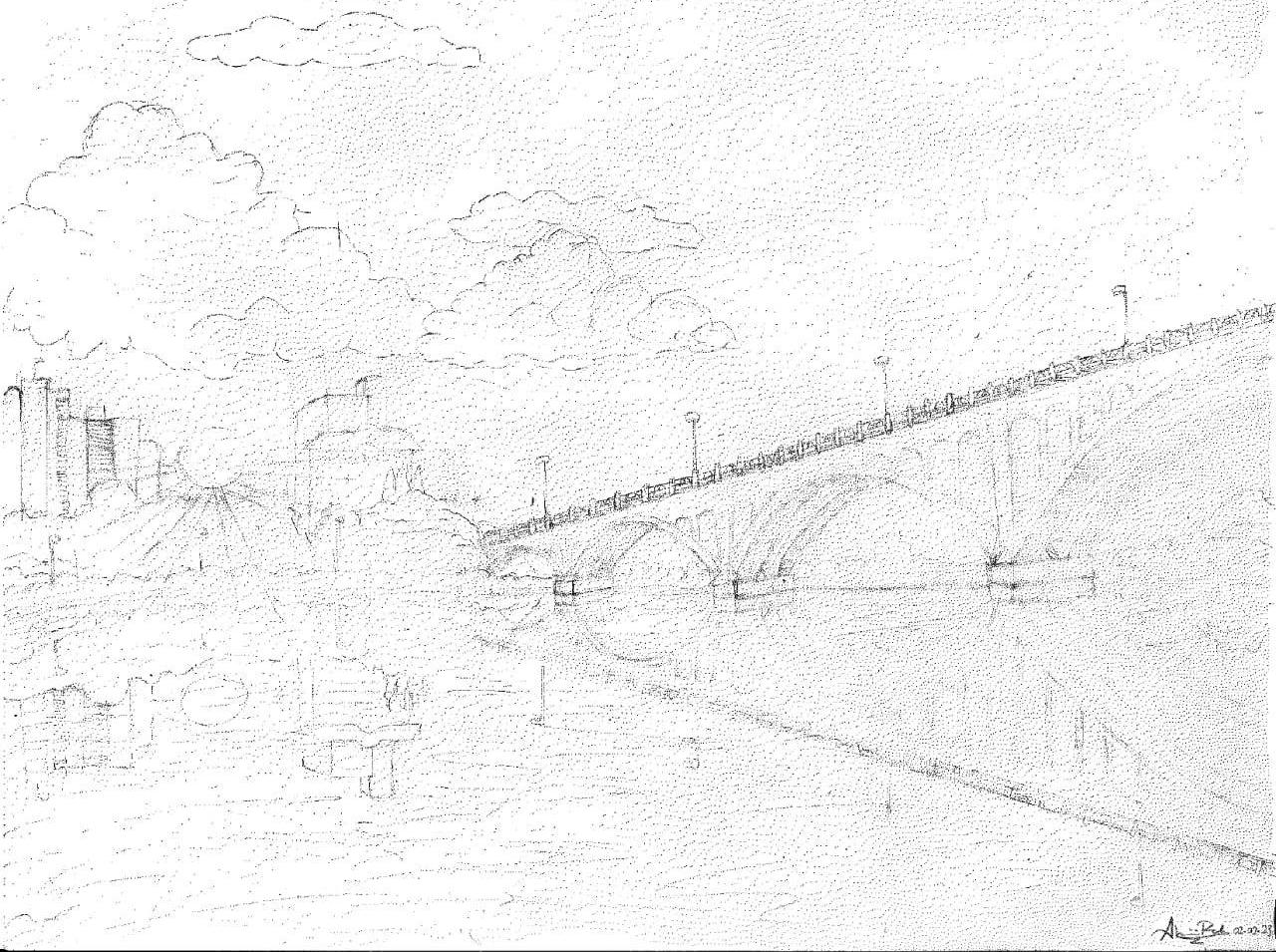
In this piece, I wanted to show Saskatoon’s beautiful skyline including its river. Even though drawing the reflections in the river was challenging, it drew to my attention how important it is to always have a good character because that will also reflect good work.
NONFICTION “horizon” / 12
A Saskatchewan Landscape by ABENA AMANKWAH-POKU
Pencil on paper
Dream of Tomorrow
by LIAM TIMMERMAN
Digital art
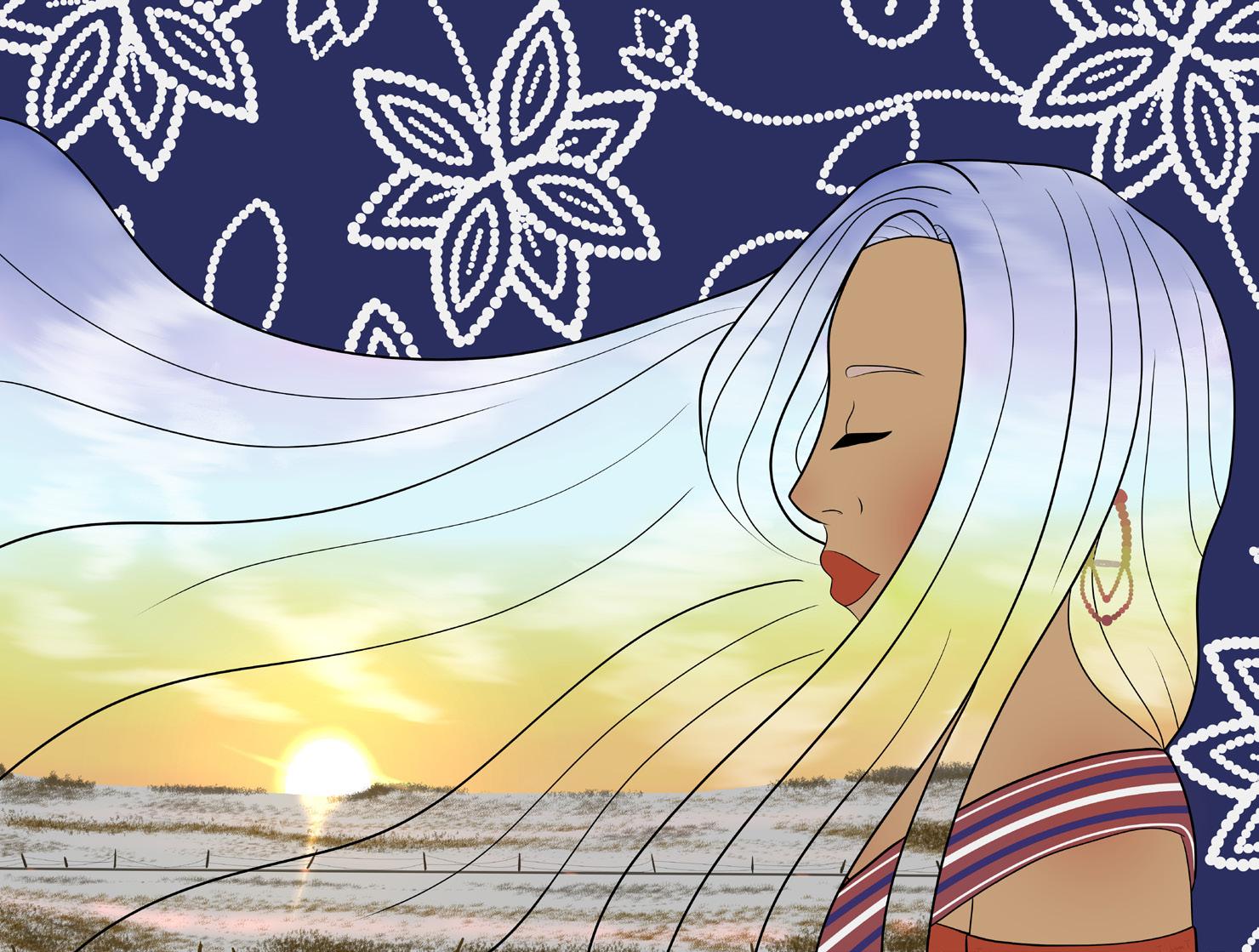
An Ode to Borscht
by MARTA KRUEGER
Print, linocut and ink
“An Ode to Borchst” is a multiblock Linocut print, created specifically as a symbol of my Ukrainian Heritage. Since the illegal invasion of Ukraine by Russian Military troops in 2022, different elements of Ukrainian culture have taken on new roles as symbols of Ukrainian identity. Ukrainian Borchst is one of these symbols. Ukrainian Borchst can be found as a staple food in any Ukrainian household, and is vastly considered to be a key part of the fabric of Ukrainian heritage, identity, and traditions.
Glory to Ukraine, Glory to her Heroes!
I created “Dream of Tomorrow” to highlight the physical and spiritual connections to the earth. I wanted to showcase that we are connected to the earth, both body and mind. I want the audience to see both the beauty of earth and the beauty of Metis culture. I specifically chose a woman in red as a nod to the ongoing threat to our women, girls, and two-spirit people. The inspirations for this piece was Metis beadwork, a photo I took near my hometown, and wanting to shed light on a cause I care dearly about. I want to continue to use my artwork to both express physical beauty and to use it as a way to shed light on issues important to me.
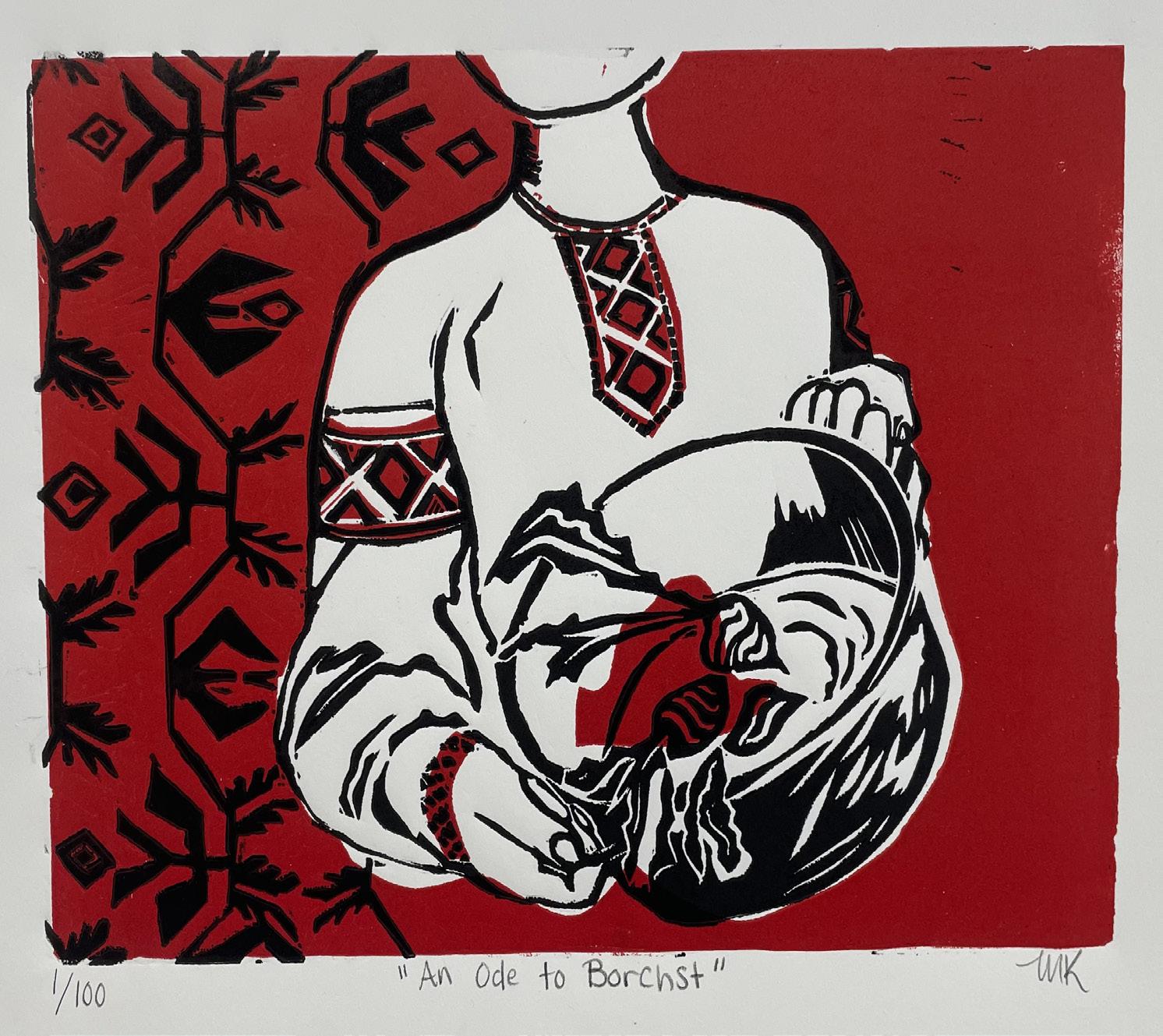
13 / in medias res VISUAL ART
Слава Україні, Героям слава!
Rigby
Becca Dunkle
Your ghost resides in each crevice of my home— and in the spaces between my fingertips you managed to slip through. Each floorboard is a reminder of where your feet have walked, each bed, a reminder of where you’ve laid. What a tumultuous predicament I find myself in— forced to spend my days staring towards the corner of a room, imagining your shadow upon the wall. These walls once encased your beautiful soul, and, in a way, you are now eternally bound to them. I sit writing this poem, wishing I didn’t have to— foolishly hoping to open my eyes to a world where you are still present. I know that each moment I spend thinking of you is hopeless, but not wasted, as nothing done in your honour could ever be a waste. I will love you in perpetuity— in a never-ending cycle where I barbarously attempt to replace the love you bestowed upon me. I would’ve done anything for you, anything at all. And now you reside in an urn beside my bed.
Now, if I look out upon the horizon— I know that’s where you are. Somewhere far from here, somewhere where all the light you brought into this world will shimmer in your glorious eyes. Somewhere pure, and good, where suffering is a word only imagined. Where you will be surrounded by every good thing you ever loved, and one day I will meet you there. One day, we will dance together in Death’s great hall, hand in hand, as we were for the best years of my life. He will arrange for us a grand feast, where all will cheer for the completion of our souls. The Sun will rise in your honour, and the Moon will set to show that this darkness has ended. You were the brightest part of my life.
Oh how I refuse to believe that you’re gone. All I can do now is yearn for the day where you will stand before me once again.
“horizon” / 14 POETRY
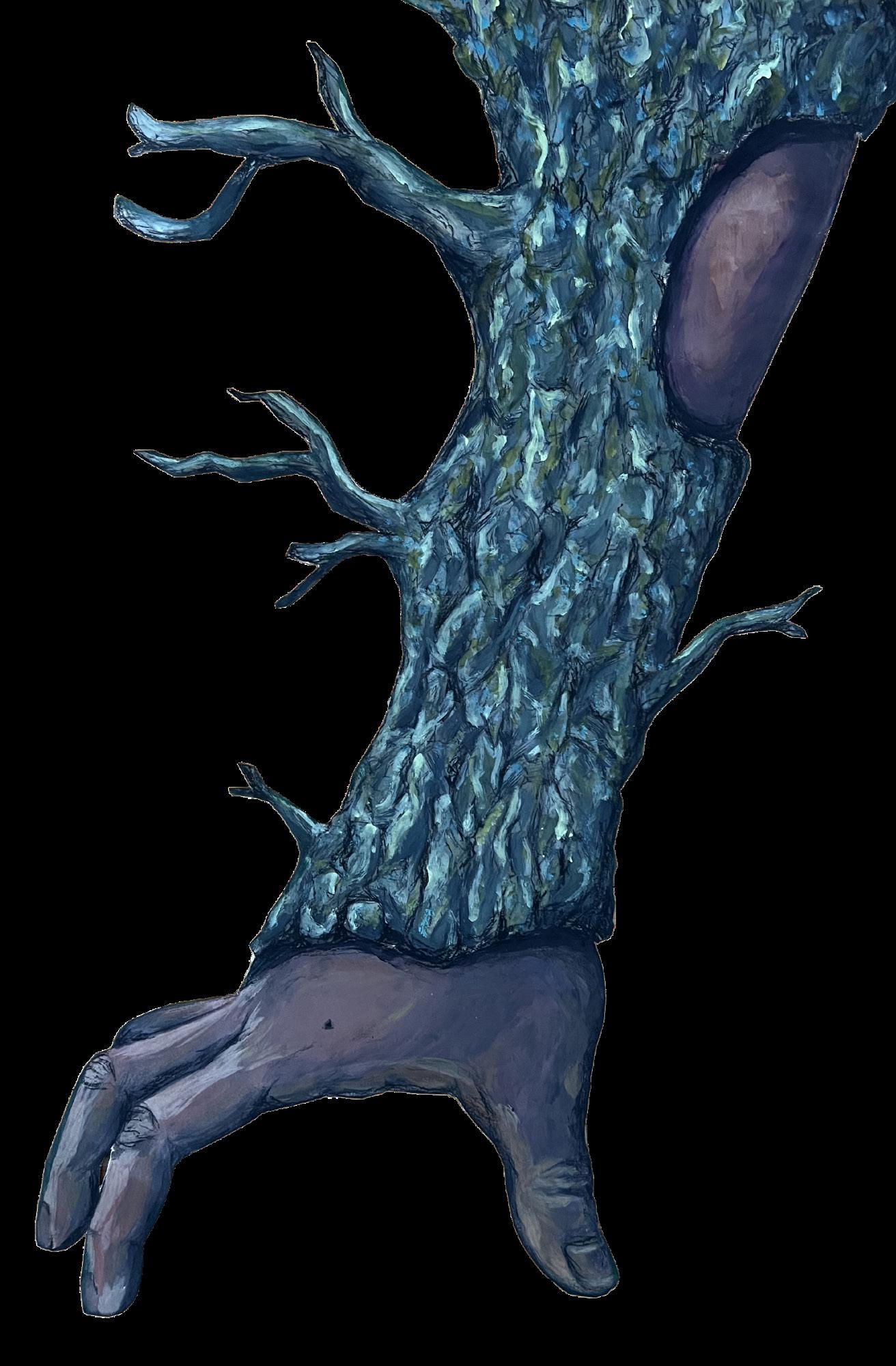 Reach by MEERAH
Reach by MEERAH
Paint, conté and willow charcoal sticks on paper
“Reach” depicts the idea of the body and nature becoming one. Spending more time in nature helped broaden my horizons and calm me down. Sometimes you have to detach yourself from all the noise and direct your energy toward nature’s experiences.
your
mother and i have the same hands
Greg Orrē
for how many more days will your hand fit in my palm? i ask a lot of questions now i never thought before. my hand covers your entire head. my hand isn’t even that big. did you know your mother and i have the same hands? you can hold on whenever you need. you can reach out and i will be there.
when my hands are wrinkled and cold varicose and virescent then eventually a memory read this poem to hold my hand. touch the words to feel my fingerprints. the warmth radiating from your body into my left arm lines this page.
you grin.
in some far away land we walk into the sunset.
our hands in the air shiny and full of gold.
15 / in medias res POETRY
The Cold Welcomed Me and I Embraced It
Sesan Johnson
I started the cold
Yes, with a cold email to my Prof.
Prof replied with an ice of hope
Coldly, I applied
Rejected by the admission committee
I wonder why the coldness from the committee
Hope was flashed again
Become cold and flared
I vehemently launched into the cold hope
Not minding what may become of me
Finally the cold embraced me
Afterall, Saskatoon is cold.
The coming cold was embraced without hesitation
Launched into its possibilities with hope
With delay in approval and permit
Me wonder why the cold shoulder
My ambience became cold
With approval and permit
I became ready for the cold
Yes, ready to dare the cold.
Flying and crossing borders
Cold grips my soul
Wondering how to survive
And what to survive with
Advised to get my cold outfits
Methought I had experienced enough cold
Welcomed with cold the cold of Saskatoon
I became cold, not no sure of what to expect
Called my woman
She asked, how are you?
Replied, I’m cool
She replied, indeed you are cold
Truly, I’m soaked and shocked by the cold
Now I know why I’m cold.
Left a city of brown roof
Now in a city of white roof
Left a city of brown street
Now faced with white street
Slugged it out in the snow slowly
Won’t be cold to the cold
Embraced the cold
Because the cold also welcomed me.
As snow blanketed Saskatoon
I also blanketed myself with a duvet
After blanketing my skin with ‘aboniki’
Now protected again the harsh weather
Looked good in winter picture
Cladded in layers of jacket, scarf, and hat
Avoiding slippering ice
Trending, treading, and dreading the winter
Is Saskatoon’s winter fair?
What should I say?
To say I enjoy it is a big lie
But what can I do about it?
Providence makes it so.
Salute to the First Nations
Who first dared the cold.
“horizon” / 16 POETRY
Dangerously Below the Horizon
Krista Wilde
My real Ma is dead. I hear the kids in the schoolhouse whispering behind my back, calling me the “Ma Murderer”. Sometimes when my cousins are trying to get a rise out of me, they call me that too. Most of the kids at school and all of the cousins are bigger than me, so I know I don’t stand a chance. Plus, the beatings are shorter if I stay quiet
My new Ma is beautiful. She has shiny long hair that she keeps in a thick braid and her eyes are as big as daisies. I made a picture of her when I was a little kid and used wild daisies for her eyes and made a braid from horse hair ,the horses didn’t mind the haircuts. She loves that picture and still has it on top of the pantry. She says it’s extra special because I made it and because her name is Daisy. In the summertime, when the daisies are in bloom, I pick some for her after, I have done my chores. She puts them in her hair, and looks even more beautiful, or in a vase on the table. Pa pushes them out of the way and asks gruffly, “Why do we need these weeds on the table?” But Ma cleans off the table after he leaves and proudly places the vase of daisies back in the centre on a crisp white linen doily.
Pa wants me to call her Daisy, not Ma, but I don’t listen to him. He gave up punishing me for it long ago. Now, when I call her Ma all he does is frown at me. I like to call her Ma and I know she likes it too. I see her eyes twinkle when I do.
I don’t remember when Ma arrived because I was just a baby. Pa had to write letters to faraway places to find a new wife. He couldn’t have been expected to take care of a baby and a farm as a widower. And besides, babies are women’s work. Ma answered his letters and took a long train ride to come to us. Secretly, I think Pastor Hanson helped him write the letters, Pa couldn’t have written anything good enough to get Ma to come. Pa isn’t a sweet-tempered man but if Ma has regrets, she never lets it show. She goes about milking the cow, washing clothes, tending the garden and all, without complaining.
It’s fall now and she’s canning the vegetables from the garden. Despite being busy, she always has time to
hear about my day or about the book I’m reading. Pa says my first responsibility is the chores but Ma says that reading books are important, so sometimes she lets me stay in a little longer to finish my chapter.
Pa wants me to be strong, like him. He says I need to be tough to take over the farm because there’s no one else. Pa and Ma never had children of their own. Pa had wished that God would bless him with many children but all he got was me. And I’m not big like him. Despite having plenty of food to eat, my arms are skinny and you can see my bony knees and skinny legs through my pants.
Once when he was really frustrated with me for not being able to saddle the horse on my own, he said, “how could a skinny runt like you have killed your Ma?” I think he misses my real Ma.
Ma explained that Pa is not really mad at me for killing my real Ma; after all, lots of ladies die in childbirth and you can’t blame the babies or the mothers. She told me that only God knows why he takes some of us early and leaves others. She says that all she knows is that she is very glad that God left me for her to find. Besides, Ma says that I will grow to be big and strong like Pa someday and that it’s just going to take some time.
It’s my job to clean the chicken coop. It’s important to Pa that I work more to become big and strong, so I don’t stop to rest. I can see Pa approaching. He walks with long strides, his big hands swinging back and forth with each step.
“This is supposed to be done so you can go goose hunting with your cousins the day after tomorrow,” Pa says with a scowl on his face.
“I don’t want to go hunting with them anyway,” I reply, wiping the sweat from my brow. And I mean it. I hate going anywhere with my cousins. They are bullies.
“This year you’ll be able to shoot a goose yourself though,” says Pa encouragingly.
“I can hardly shoot the gun at a target, let alone a flying bird,” I say defeatedly.
“Tomorrow, we’ll practice,” replies Pa.
FICTION 17 / in medias res
I’m shocked! Pa actually feels bad for me? This must be important..
The next morning, true to his word, Pa comes into the kitchen holding the 12 gauge.
“Come on ” he says.
“Where are you off to with that thing?” asks Ma.
I see Pa has the pistol tucked into his belt. Ma doesn’t like the pistol. She says they’re bad because people only use them to kill other people.
“We’re going out practicing so he’s ready for goose hunting this weekend”, Pa replies.
“Surely you aren’t sending him out with those boys? Last year he came back covered in bruises and had a black eye!” Ma says with a frown. “Those boys are nothing but trouble.”
“Well maybe if he wasn’t such a wimp, they wouldn’t pick on him,” Pa replies.
Ma puts her arm around me and says “Look Pa, he ain’t in a hurry to grow up. He doesn’t have to prove anything to them”.
She’s right. I don’t have to prove nothin’ to my stupid cousins, but I do have to prove to Pa that I’m no wimp.
“Let’s go”, I say to Pa, blinking back tears. Ma shakes her head in frustration as we walk out the door.
Practicing with the 12 gauge turned out to be a disaster, as I thought. The kickback is so strong that it nearly knocked me over. Although Pa may have been disappointed at first, he cheered up when I asked if we could shoot the pistol. It turns out I am pretty good at it. I hit the target and Pa actually smiled!
Despite having to go hunting with my cousins, I am still happy after yesterday’s practice with the pistol. I was up early and finished my chores. Ma packed my lunch and she has given me a candy stick. Pa says candy will stunt my growth but Ma knows I like it. Sometimes when she goes to town to pick up supplies, she’ll buy one for me. She’s the kindest person in the whole wide world. But, she doesn’t know that the cousins will just steal it from me, so I decide to hide it and have it when I come home.
I make my way to my bedroom to hide my candy before cousins arrive. As I walk past their bedroom, I notice that Pa’s pistol is in its holster hanging on the bedpost. Pa is gone to butcher pigs with some of the
neighbours and I’ll be home from goose hunting long before him, I thought. I smiled, Ma will never notice the pistol’s gone and it might come in handy with those nasty cousins. If I can show them I can shoot, then maybe they won’t bother me no more.
Quietly, I take off my coat and put on the holster. My coat hangs halfway down to my knees. Pa bought it three sizes too big saying I would grow into it. Lucky for me, it covers the holster completely.
I hear the cousins shouting my name. “Come on runt, time to kill some geese,” calls Chester. He is my oldest cousin. He’s not very tall but he’s stocky and strong. When he punches, it really hurts.
Ma is in the kitchen and she has a worried look on her face.
“You’ll be back at sunset?”
“Yup,” I reply in the most cheerful manner I can muster.
“Not a minute later than that sun touching the horizon or I am going to get very worried. Are you going to the slough out through the back of the Walker place?” Ma asks.
“Yup,” I reply with a forced grin.
“Be careful today, Billy. I think those boys are still too young to be shooting guns,” she says anxiously. “Pa will be working late and too busy to come look for you. If something happens and you don’t come back on time, I…”
I cut her off before she can finish. “I’ll be fine,” I say with a real smile this time, thinking of my hidden pistol. I give her a kiss on the cheek and scurry out the door before she notices the gun.
We hunt, or the cousin’s do anyway. I walk behind and they occasionally whistle at me like a dog to catch up. The sun is getting low and it’s quickly getting colder now; not much longer until sunset. Chester takes a rope that has the geese tied by their necks and flings it over my shoulders. “Since you are too useless to do anything else, you can carry ‘em back,” he says with a sneer.
We walk through the field and head towards a small clump of aspen trees. The dripping geese have made my clothes wet and I can feel a chill sinking into my bones. The weight of the birds makes every step hard. I am pretty sure I am carrying half my weight in dead, smelly geese but I know better than to complain or ask for help.
FICTION “horizon” / 18
“Let’s go through the bush,” barks Chester, “it’s the quickest way to the road if we head through there. We’ll come out at the old Walker place.”
I’m relieved to take the shortest route home. The Walker place has a small caved-in barn and a decrepit house. No one has lived there for many years.
“Did you know that there’s a creep snatchin’ up kids?” my cousin Walter asks. Walter is Chester’s younger brother. He likes to twist arms.
“No, there’s not,” I say. Do they really think I am gonna fall for this?
“Yeah, sure is,” says Robert. He is six feet tall and only fourteen years old. He likes to kick. “The creep has taken five kids this summer! Word is that he tortures ‘em before he kills ‘em. The sheriff has found bodies but he hasn’t told the public yet because the mothers would be beside themselves.”
I try to look unconcerned. The weight of the birds is making the rope cut into my shoulders and the pistol is weighing heavy on my waist.
“He ‘specially likes small kids. Like you, runt,” says Walter. “Rumor has it that the sheriff thinks he has Floyd Stone.”
Floyd Stone disappeared in spring. He was out checking fences and hasn’t been seen since.
“I heard that the sheriff thinks he probably has ‘em boys tied up in an abandoned farm,” says Chester.
“Probably hidin’ out in an old farm like the Walker place,” says Walter.
“We walked right by the farm this morning and didn’t hear a thing,” I say with confidence.
“That’s just it! No noise at all and that’s why it’s strange,” Chester whispers, his eyes narrowing with suspicion.
“I’m not scared,” I say as I think of my pistol.
“We’ll see about that!” Yells Robert. And with that, the cousins all take off running through the trees.
I run after them, but the birds are heavy, and the pistol is knocking on my thigh. Out of breath, I slow to a walk. The sun is dipping dangerously below the horizon.
I make it to the edge of the bush and see the farmhouse in front of me. I know that behind the farmhouse is the driveway which makes its way out to the road. I stop and listen intently. I do not hear the cousins. Carefully I make my way through the tall grass.
Not so much as a cricket is chirping.
Crunch-crunch-crunch. Is that me making that noise? I stop but the noise continues. Its footsteps! As quietly as possible, I drop the geese and rush to take cover behind the house. I feel for the pistol.
Don’t be scared. You have a pistol. I gently pull it out and pull the hammer back. I can hear the rustling of the long grass. It’s a single person coming down the side of the house. I have nowhere to hide.
A figure appears at the corner. It is twilight now, and I can only make out the dark outline of a person.
“Stop or I’ll shoot!” I choke out.
“Billy…?”
But it’s too late. My finger has tightened on the trigger. The shot rings out in the crisp fall air…
* * *
Days later, I take the dried daisies from the picture on top of the pantry and I put them over closed eyes. Her hair still shines beautifully in the casket. They close the lid and carry her out of the church. I follow behind.
I could hear the people in the last pews solemnly whispering, “That poor boy; he killed his Ma.”
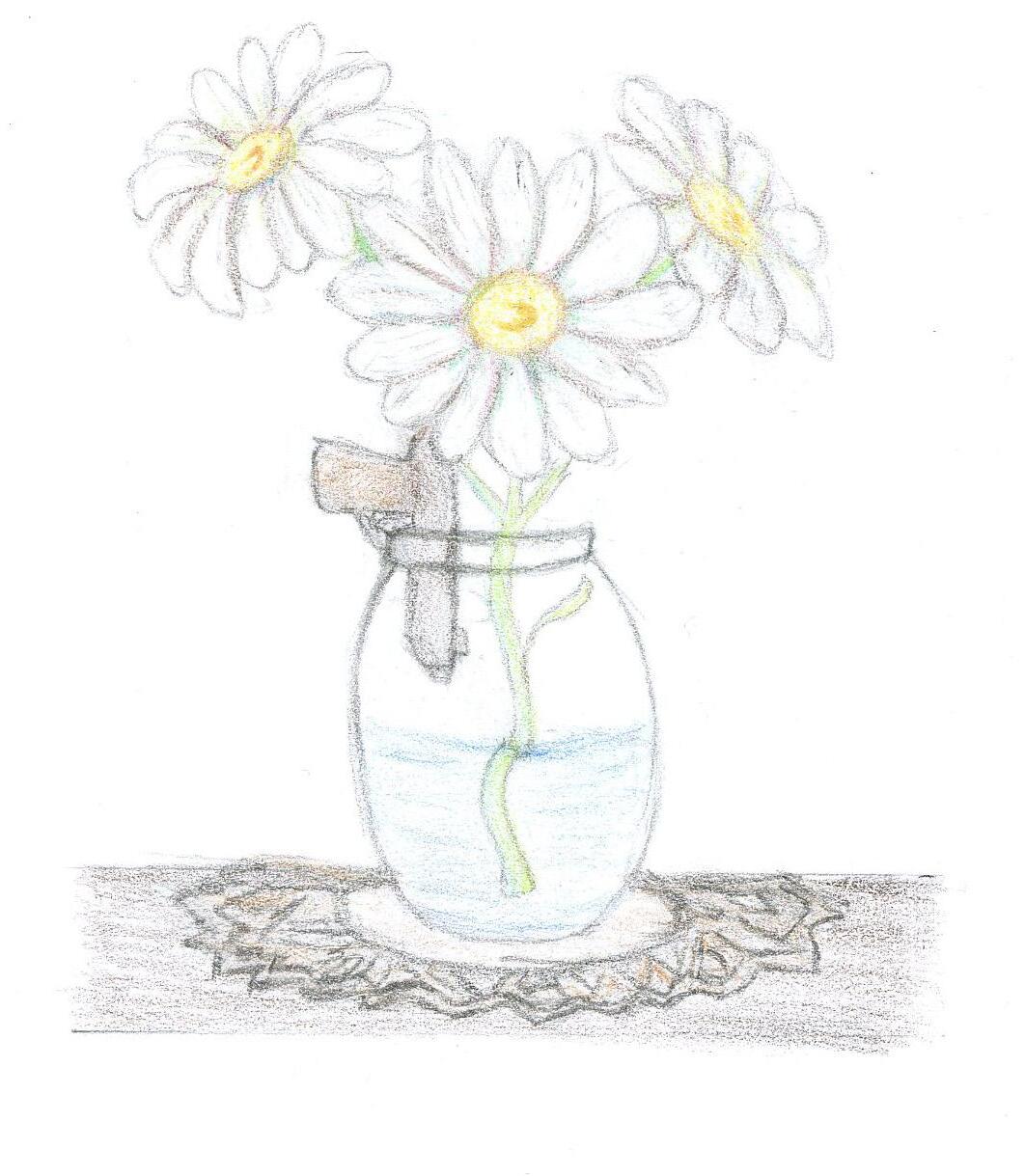
FICTION 19 / in medias res
Home is Where the Sun Sets
Robyn Claypool
In late October, a pacific sun fades to the west, where you cannot see it fall to its slumber, blanketed in mists, wet concrete, raindrops grazing tall panes of glass.
Here, the prairie sky is dry and clear, concrete buildings so low that I can watch the sun slip away slow and steady over the earth.
Here, when the leaves turn to embers, no wet drops fall from the heavens. I find myself worried, I find myself weary. This is the time I usually feel watered, after the long dehydration of a scorching summer.
Out there, on the coast, I found solace in the dark wet shadows of my home. Now that I’ve left them behind, somehow I know they will always call to me.
Out there, were ocean tides and the faces of my friends. I see them here here only in dim corners, or in puddle reflections that remind me of those quiet coastal silver skies.
I could almost dive into them and go right back to the canopies of emerald pines rising from the salt of the mountainous earth.
But I don’t. I can’t, I am here now and a bright prairie sun sets itself inside my chest. My snowy eyes reflect the vast blue skies over miles of alfalfa and canola fields, lakes dreamy and slow. They make a nest inside my bones, blood and soul.
I know home is what you make of it although I often wonder where I am truly meant to be.
At any moment in time? In any particular place? I know now that it must be here, as this is where I am. Beneath this sky. Watching this sun. How can that be wrong?
“horizon” / 20 POETRY
whatever it was it was and it is not it now
Greg Orrē
whatever it was it was and it is not it now
whatever it was it was and it is not it now whatever it was it was and it is not it now whatever it was it was and it is not it now whatever it was it was and it is not it now
whatever it was it was and it is not it now.

“Before the Storm” depicts those strange moments of silence and tranquillity before a disaster. Living in the 21st century has all kinds of surprises everyday. Media is filled with natural disasters, wars, and etc. I think we are all living those moments before a storm, constantly worried that this silence is not right and something awful is going to happen, anxiety on top of anxiety.
Before the Storm by NARGES PORSANDEKHIAL Photocollage on paper
21 / in medias res POETRY
At the Trial of God, You Will Meet Your Body
hoiyan
Today, I found out that God exists. Not as a being or a whisper or a state of mind; God is the torment I feel as this limp body–my body–is splayed naked on a steel tray before me.
That foreign, bare chest displayed for approaching angels to leer at, dilapidated stretch marks clutching onto uninvited curves, a physicality sectioned off based merely on chromosomal affairs.
I beg for mercy, I beg for mother dearest mother please help me. Instead, she stands amongst the angels, grips burning incense, and pierces through the flesh, hushed prayers slip through God’s upturned lips.
Today, I face my own body as a trial of terror. I scream and shriek at the angels to cover it all, I scream and wail at the disconnections from a blurry idealization to the sight I’m facing, I scream and lacerate the wrong body I am to be put into.
I draw two incisions for a beautifully scarred, scarlet chest; refined dimensions curated to perfection–the body that is finally all I could be, an ethereally bloody figure stripped of femininity. A sigh of liberation for my flawless product, but my handiwork reversed at once for the glory of God’s design.
With wet hands and glossy eyes, I beg for mother again but she stays with the angels to stare. She looks to God, then tells me that is your predestined body, and I scream in mourning as the torment that is God dispatches my flesh into our today.
Today, I found out I had died in front of myself before I was born.
“horizon” / 22 POETRY
POETRY
Peace on the Horizon by
Lara Paul
Photograph shot on iPhone 11 Pro
This image is a testament to the resilience of modern humanity—who work tirelessly to survive well, and who retreat to nature for healing. The moment captured begs us to wonder; Why are we so drawn to the healing spaces of nature? And, when we are ready, What is waiting for us over the next horizon?
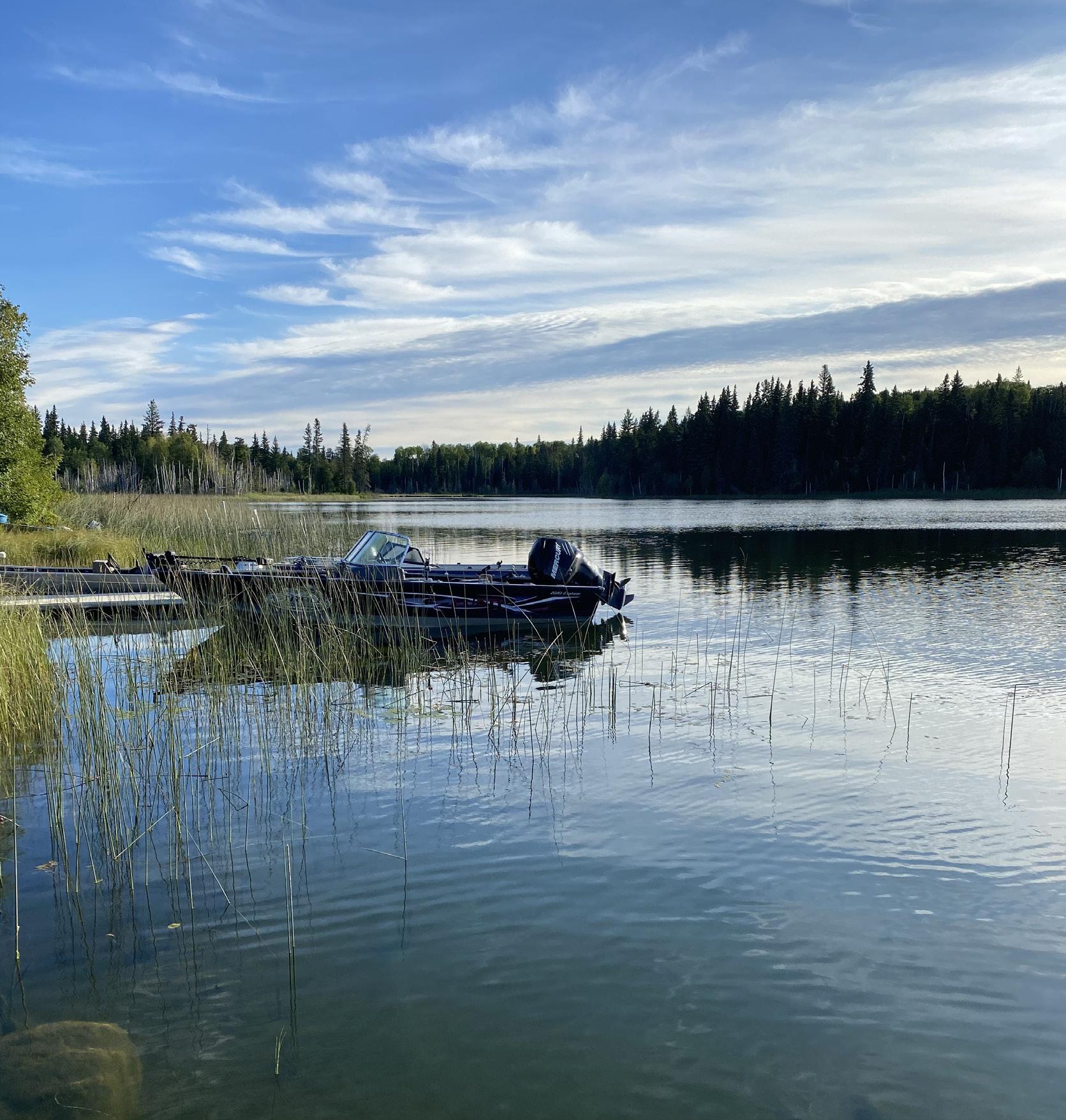

In the Partial Shade
Jocelyn May
As the wind flicks Grass bends to give a kiss. It holds me light As I have no need to fight.
Here alone under this tree It’s just you and me.
The sun meets at a line And I have a feeling things will be fine.
23 / in medias res
Once They Were Children
Emily Zbaraschuk
Growing up around the City, the homeless are as commonplace as street signs or traffic lights. They wander through the Superstore parking lot, asking to put away your cart so they can nab its loonie. They stumble into Wendy’s to warm up, lamenting that Jesus doesn’t care. They walk beneath street lamps, their legs thinned to pipe cleaners by heroin, their scantily clad bodies transfigured into profits by pimps. They conduct imaginary symphonies on park benches, the only audience the voices in their head. They huddle on street corners, curse at passersby, remain unidentified at morgues. But for the most part, I only saw them from the corner of my eye, from beneath my lowered brow, always lingering in the periphery. I looked away when they got too close to my car, my wallet, my life.
the $1.50 tongs I’d bought for this exact reason to pick it up. It thudded in the biohazard container.
“See that blue thing there?” Alyssa gestured at a nickel-sized, u-shaped plastic tab sitting nearby. “It’s from the top of the tube.”
For the next few days, as I walked around the City, all I saw were those tabs. Once you knew what to look for, you saw them everywhere, scattered like confetti among cigarette stubs and dried leaves. The detritus of rough living and that pulsing desire to forget.
***
I’d been hired by the City to be a playleader, one of the lucky high school or university students paid to entertain kids at one of the City’s playgrounds. After a week of orientation at the Community Centre—which, hosting the only patch of grass near downtown, was a popular loitering spot for vagrants sharing needles—I was assigned to Middleground Park.
The park’s southern half boasted a waterpark, while its northern half—where I would spend most of my summer—was filled with grassy fields and elm trees. The highlights? A playground with the basics: slides, swings, and monkey bars. About a hundred yards away, a forest-themed splash pad. Behind the splash pad was our home base, a cement storage building coated with grey paint and graffiti.
My first day on the job, I arrived in my blue and white pinny, a pair of flip-flops on my feet and a red lanyard around my neck. Alyssa, my playground partner, came soon after, and we began our safety check. As we strolled through the park, we collected broken glass, a used needle, and a carton of clear liquid. It was likely illicit, stored in a plastic tube the size of my finger and the colour of medical masks. Donning gloves, I used
As part of our daily responsibilities, Alyssa and I had to assemble a yellow and white flag that said “PLAYGROUND PROGRAM TODAY” in bubble letters. Once, we were setting up the flag when an Indigenous woman riding a bicycle on the park’s sidewalks stopped near us. Her belongings were slung in a ratty backpack over her shoulder. She pointed her chin at the metal flag pole lying unassembled on the ground. “Those for beating Indians?”
I glanced at Alyssa.
You’re the one in charge, her widened eyes replied.
“No,” I stuttered. “No, we don’t beat… Indigenous people with them.” Then I added, stupidly, “That wouldn’t be nice.”
The woman barked a laugh and rode off, content with our discomfort. A car honked as she cut through a four-way stop at a diagonal.
On our way back to home base, Alyssa tugged at her ear. “What was that?” she said. “What do you even say?”
I shook my head. What do you say?
***
On a hot day in early August, I was in the storage room, filling out paperwork, when a frumpy woman in a visor knocked on the door. She stood with her legs shoulder-width apart as if she expected me to bulldoze
NONFICTION “horizon” / 24
***
her. “Are you in charge of this place?” And added, before I could answer, “Do you know what’s happening?”
“Is something wrong?”
She gestured over her shoulder at the splash pad. “Take a look.”
All summer, the concrete pad had been ground zero for all sorts of predicaments. Skinned knees. Soaked clothes. Kids stripping down to their birthday suits. If Alyssa or I didn’t spot it first, adults would point out the error with a laugh, always charitable when children were involved. I scanned the park for the usual offenders. “I’m still not seeing what’s wrong.”
She huffed and pointed at a pair of women in the far corner. “There are hobos washing their clothes in the splash pad.”
Laundering was a first, but I’d gotten used to homeless people walking through the splash pad, giants among the screeching children. At first, I thought they simply wanted relief from the heat until, on an overcast day, I watched a man strip down to athletic shorts and shiver under the water. He was bathing in the cold so there’d be no kids running circles, no adults judging a grown man showering in public.
I watched as the older of the two women tried to replace her shirt with a clean camisole without exposing
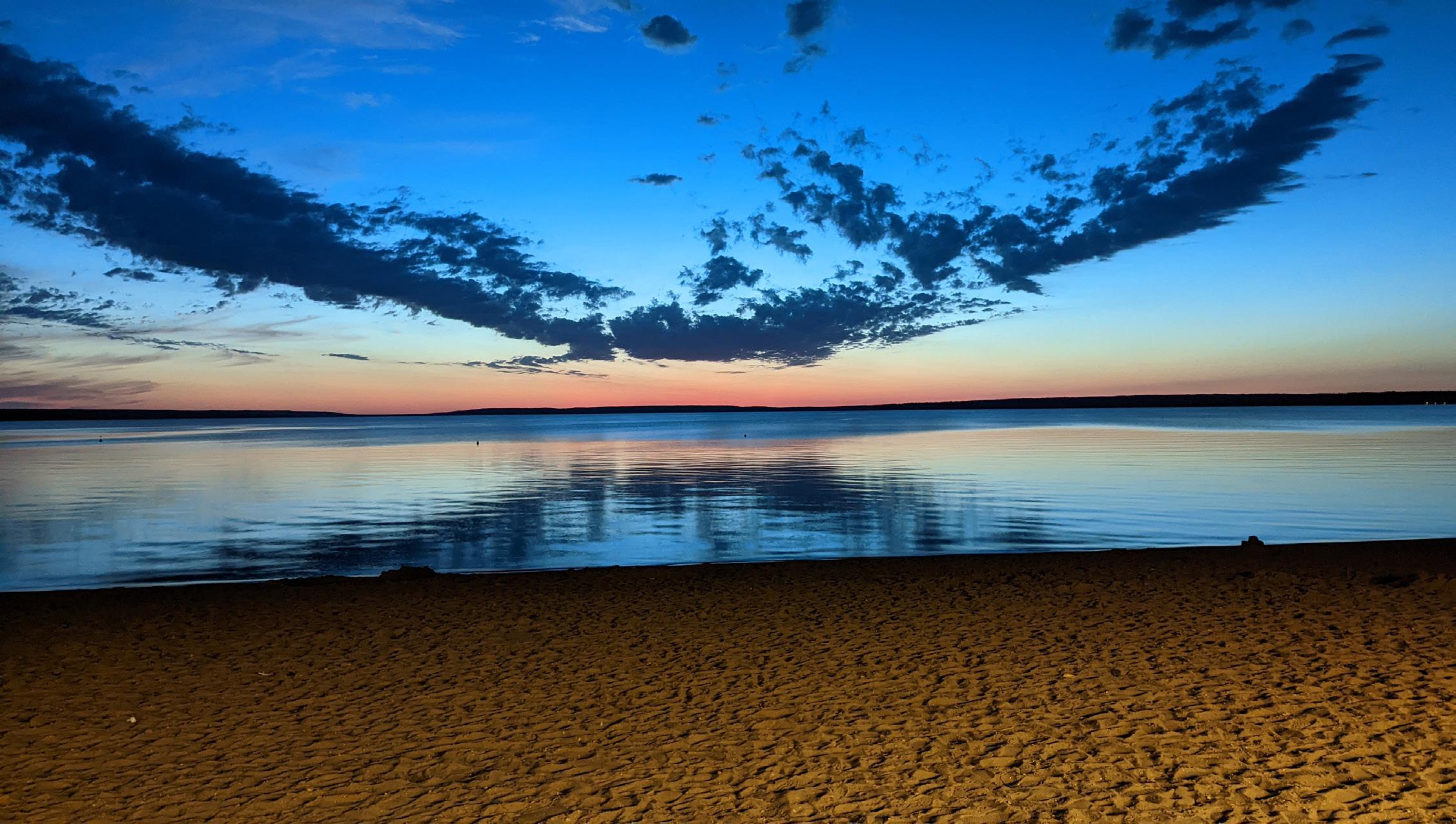
Before the Night by
JOSEPH MEDERNACH
Digital photography
I took this picture last summer, when camping with my family. However risky it may have been, I had started a stressful retail job and had been going on late-night walks to help me sleep. I noticed the quietness of the world after dark. On this camping trip, near the end of the summer, my father and I decided to go for an evening walk by the lake. The lake looked picturesque, and the emptiness of the beach reminded me of the late-night walks. Maybe you can feel the magic: the calm, quiet, emptiness. At least you can see the beauty of the edge of the day.
* Appeared on the artist’s YouTube and Instagram pages.
NONFICTION 25 / in medias res
herself. She contorted her arms to shimmy the dirty shirt around her waist. “I’ll keep an eye on them,” I said.
“They’ll flash the kids. Tell them to find somewhere else to clean up.”
I watched them distance themselves from the kids laughing as they played tag. “They’re keeping to themselves. Unless they approach the kids, it’s a public park.”
She ended up dragging her kids and husband from the park, shooting daggers and accusatory index fingers my way. All I’d done was follow protocol: we were supposed to let them be unless they posed a threat to the kids. I know she wanted me to tell them to get lost, to return to the West End or the Downtown—at the very least, somewhere where she wouldn’t have to see them. But to me, they didn’t look suspicious. They looked like women clutching the last shreds of their dignity.
Suzie was about to enter grade one and Aiden into kindergarten, yet their words were a mash of mixedup sounds and lisped syllables. They’d get frustrated when we couldn’t understand, but they were sweet kids; I wanted them to be okay. But how do you learn to read when you can barely speak full sentences and have parents who are too tired to listen? What happens if your life is scaffolded with bird nests and you need pillars?
Every day of orientation, our supervisors reminded us how important our work was. For some kids, our program was the only chance they’d get to visit the waterpark. For others, snack time was their only opportunity to eat a healthy meal. And for others, it was an escape from home until school reopened.
The kids I’d come to know that summer had potential like puddles and rubber boots have potential. Most of them leapt into the mud trusting that when the fun of splashing was over, someone was ready to help them clean up whatever mess created along the way. Someone would wash the dirt from their clothes, wipe the grit from their face, retrieve their boots from the mire. But with some of them, you’d see glimpses of their parents and start to wonder. When they found themselves trapped, would there be someone to pull them out of the muck? Twenty years from now, would you see them sleeping in an alley off Central Avenue? Would they beg you to spare some change?
There were two siblings, Suzie and Aiden. Their dad dropped them off once. He wore a shirt with “FCUK” written across it. A young woman hung on his profanity-tattooed arm. The rest of the time, their mom brought them to the program. She walked hunched over—two heart attacks, she’d said, and at risk for another if she didn’t “get them out of the house.” With two young kids and a toddler, the summer program was priceless. As I guided her through the form, her hand struggled to control the pencil. Letters staggered onto the page.
All summer, when I stumbled upon those kids, I tried not to wonder too much. I played Home Free and Go Fish. In the background, the police escorted a man out of the park. I decorated cupcakes and paper plate masks, and in the background, a woman naked from the waist down clawed at her arms, at the sores around her mouth; a man drank water straight from the splash pad, too ashamed to ask for a cup. I mended scraped knees and bruised relationships. Always, in the background, that stomach-lurching thought: they were all children once, and then they grew up.
NONFICTION “horizon” / 26
***
Transience
Graham Wall
Intellect is my winter Cold snows cover thoughts that dive like sparrows under winding teeth of ice
Emotion is my spring All feelings of boredom are transfigured by the intuition of Easter’s tides
Seeing is my summer Cyan lands and skies are dreams of grain and cloud reserved for meek eyes
Remembrance is my autumn Trees of insecurity cast their doubts upon the ground, and all the day is spent in waiting
* Previously published on the author’s blog and Facebook page.
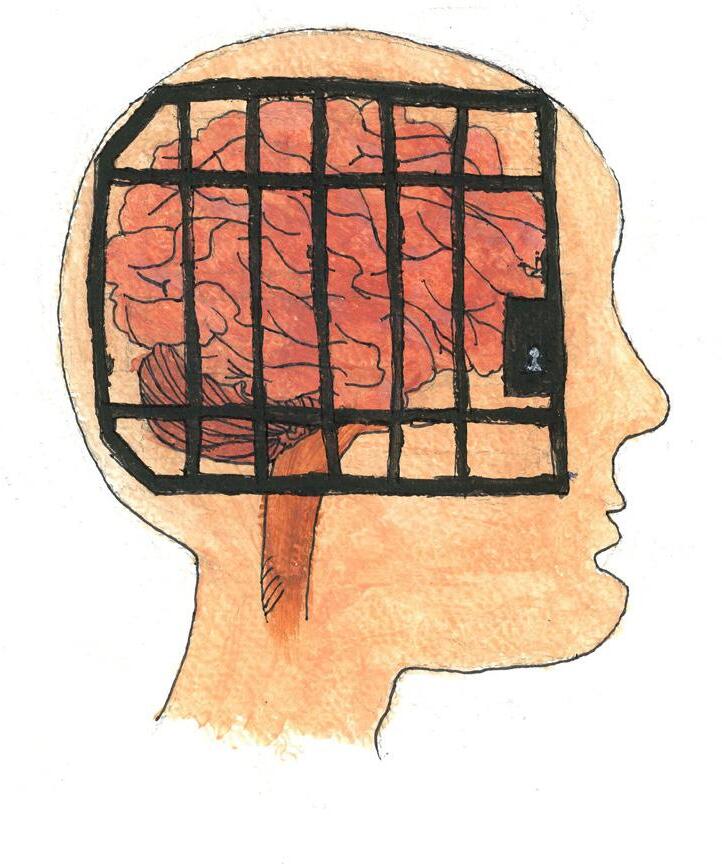
 by ASMA KAMEL
by ASMA KAMEL
Sky has always been an inspiration for my dreams and hopes. It conveys a powerful message to us: just as the sky has no limit, neither do your dreams. So, stretch your horizons and dream beyond the moon and stars.
27 / in medias res POETRY
Dream Beyond the Moon and Stars
Photography
Dreamers
Sohila Elgedawi
The wind on the marshes sings
A song so mournful that the clouds weep
But I find a home here
You’re as helpless as me
I think on how we both became this way
This world is not kind to dreamers
“How dare they want anything to change?”
When we look forwards, it only brings pain
The unending repetition of routine
The unending disasters wrought by their hands
Is this how it’s supposed to be?
Is this all there is to life?
No happiness but endless tragedies
No choices but endless decisions
What to do?
What do we do?
Nothing.
A caged lion is as helpless as a gazelle in the wild
So we look up
Head in the clouds
Our haven
After all, ignorance is bliss
Though now there’s no choice but to listen
“You have to; you need to”
But I can’t
I have no strength in me anymore
The clouds still weep, and I join them
Even for us dreamers, the sky mourns too
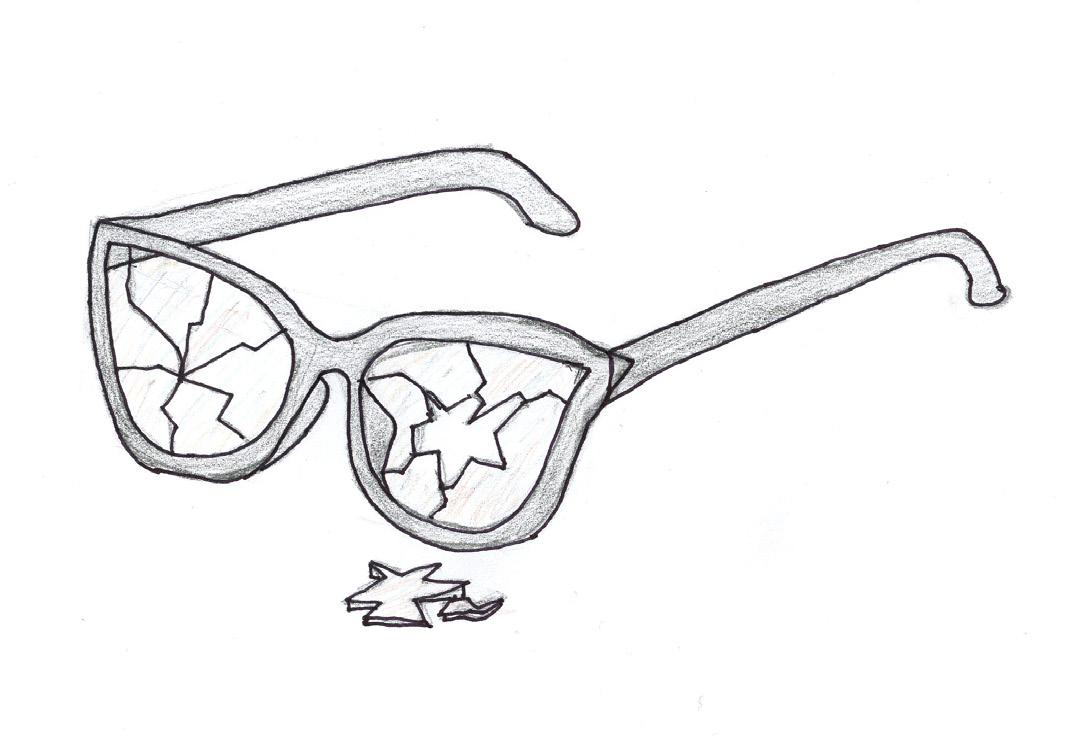
Faith
Anonymous
I don’t see a horizon my horizon any horizon
Everything is a blur
The paths that once looked clear have gone, proven treacherous Thought I made it but I’m not even near
The pearl that graces the ocean I hoped to draw strength To put things in motion To make amend
But how have I been broken by unkind unakin emotion The fears that entangle thoughts the words remain unspoken
No, I choose to break free I choose to have faith in the faith of my loved ones
Your belief makes me stronger Your courage is everything Your heart is my safe haven from where I can see clearly my horizon the horizon
“horizon” / 28 POETRY
Is the rise of AI technology a threat to the integrity of post-secondary education?
By Dr. Hannah Kirby Wood, Lecturer in Medieval History
With the recent emergence of ChatGPT in the AI landscape, there has been collective handwringing within higher education about how the chatbot carves new paths for academic dishonesty. These concerns are not unjustified: where copy-paste methods of plagiarism usually involve some manipulation of source material to fit a prompt, ChatGPT can produce an articulate response tailored to the exact parameters of a topic in only a few keystrokes. It would take virtually no effort for a plagiarist to plug an essay topic into the chatbot and pass off the material it generates as their own, producing a “paper” that appears to adequately answer the question it sets out to address. The fact that cheating convincingly is often more effort than it’s worth has always been an innate deterrent against academic dishonesty; with that roadblock removed, there is a real fear among some educators that more students will be enticed to take the easy route.
The technology of engines like ChatGPT may be novel; the impulse to cheat, however, is not. There will always be those who find ways to game the system, and
while these numbers may swell slightly with access to ChatGPT, it is unlikely that most people who are inclined to do the work themselves will decide to cheat simply because there is a new way to do so. Besides, it’s not a given that this smarter technology will outsmart professors: there are certain patterns and tells present in AI-generated writing that aren’t difficult to spot with a bit of exposure. The most troubling thing about AI is not, therefore, its facilitation of academic dishonesty; instead, it’s the devaluation of critical inquiry that AI helps to cultivate.
University educators often struggle to reframe higher education not as a results-based enterprise, but as an exercise in developing fundamental skills such as critical thinking, independent inquiry, and effective communication. As a history professor, I seek to instill in students that there is no correct version of history that we can arrive at, no single interpretation that guarantees an A; just as the study of mathematics isn’t defined by the result of a mathematical problem but rather by the way that you solve it, the study of history – and indeed, of most other disciplines in the humanities and social sciences – is defined by the process of identifying biases,
corroborating evidence, and piecing together incomplete information, not by the resulting narrative. When ChatGPT spits out a response about a historical topic, it erases the essential groundwork behind its conclusions and reinforces the impression that there is a canned and static answer that can easily be unlocked.
In my own experimenting with ChatGPT, I’ve noticed that its answers are unnuanced at best and revisionist at worst: a prompt asking ChatGPT to explain King Edward I’s 1290 expulsion of the Jews from his own perspective has Edward acknowledging the harm that was done and committing to “understanding and combating all forms of prejudice and discrimination in the present day” – a gross sanitization of the English king’s antisemitism. Determining the reliability of ChatGPT responses demands careful and critical engagement, but its selling point of convenient omniscience discourages students’ development of these capabilities. AI has the potential to chip away at the integrity of higher education by reducing disciplines to their basest parts, diminishing the perceived importance of the skills a university education is supposed to impart.
NONFICTION 29 / in medias res
PRO
CONTRA
By Dr. Caroline Arbuckle Macleod
Assistant Professor of Classical and Near Eastern Archaeology
The rise of AI technology will no doubt make an impact on the future of post-secondary education, but it does not necessarily need to be seen as wholly negative. In fact, AI technology may be able to serve as an exceptionally helpful tool, provided that professors take the time to fully explore these resources and ensure that their students understand the benefits and drawbacks of using such applications.
Consider the way that the internet and Google have revolutionized research. While students once had to visit the library and physically go and search through books for resources, there are now limitless resources available at the click of a few buttons. This has ensured much greater access to better and up-todate data at a fraction of the time and cost compared to previous models; however, this does not automatically translate into better scholarship. In fact, when students only had access to libraries, they
also had to rely almost entirely on peer reviewed, scholarly sources. Completing quality research now has an added step of wading through repetitive, poor quality or outdated opinions that have been published - often anonymouslyonline in order to get to the higher quality gems. To avoid receiving papers based on drivel, professors need to add in additional research frameworks to their classes to help students identify quality sources. While this has added to the workload of both students and professors, ultimately it leads to the nurturing of critical assessment skills while still providing that benefit of increased, globalized access to information.
AI technology presents a similar leap forward. Students are able to have an AI presence summarize and present arguments potentially based on both ignorant and outdated opinions as well as high quality scholarship – basically Google, in complete sentences. Without the additional background presented in lectures and the skills to assess the use of sources, students are still at risk of producing low quality scholarship, albeit at a much faster pace. To ensure that students do not fall into this trap, professors may need to add additional framing assignments such as annotated bibliographies or paper outlines to their syllabi with activities that
require the students to discuss their thought process and how they judged certain sources to contain quality arguments. Returning to AI tools, students can add in additional queries that allow the programs to sift through the often overwhelming amounts of data to return with better quality sources that can act as guides and supports while students work on projects. Indeed, understanding how to input better parameters will require the students to put additional effort into understanding the history and nature of the scholarship of their discipline.
Ultimately, AI technology has the potential to help students reframe and summarize information that they can integrate into papers and assignments. As long as professors are prepared to add additional scaffolding assignments, we should not fear these tools but embrace them – think of them like calculators for the humanities, or personalized Coles Notes. The main challenge will be for administration to understand the new position in which post-secondary education finds itself, and the need for greater support to provide more detailed feedback on more assignment.
NONFICTION “horizon” / 30

Long Summer Drives Across the Prairies
by RIDA PERVAIZ
Rida’s Tasaweer (word for photographs in Urdu) blur out all impurities and enlighten the hidden beauty of what surrounds her. Although nothing is everlasting, photography enables her to capture special moments for just a bit longer.
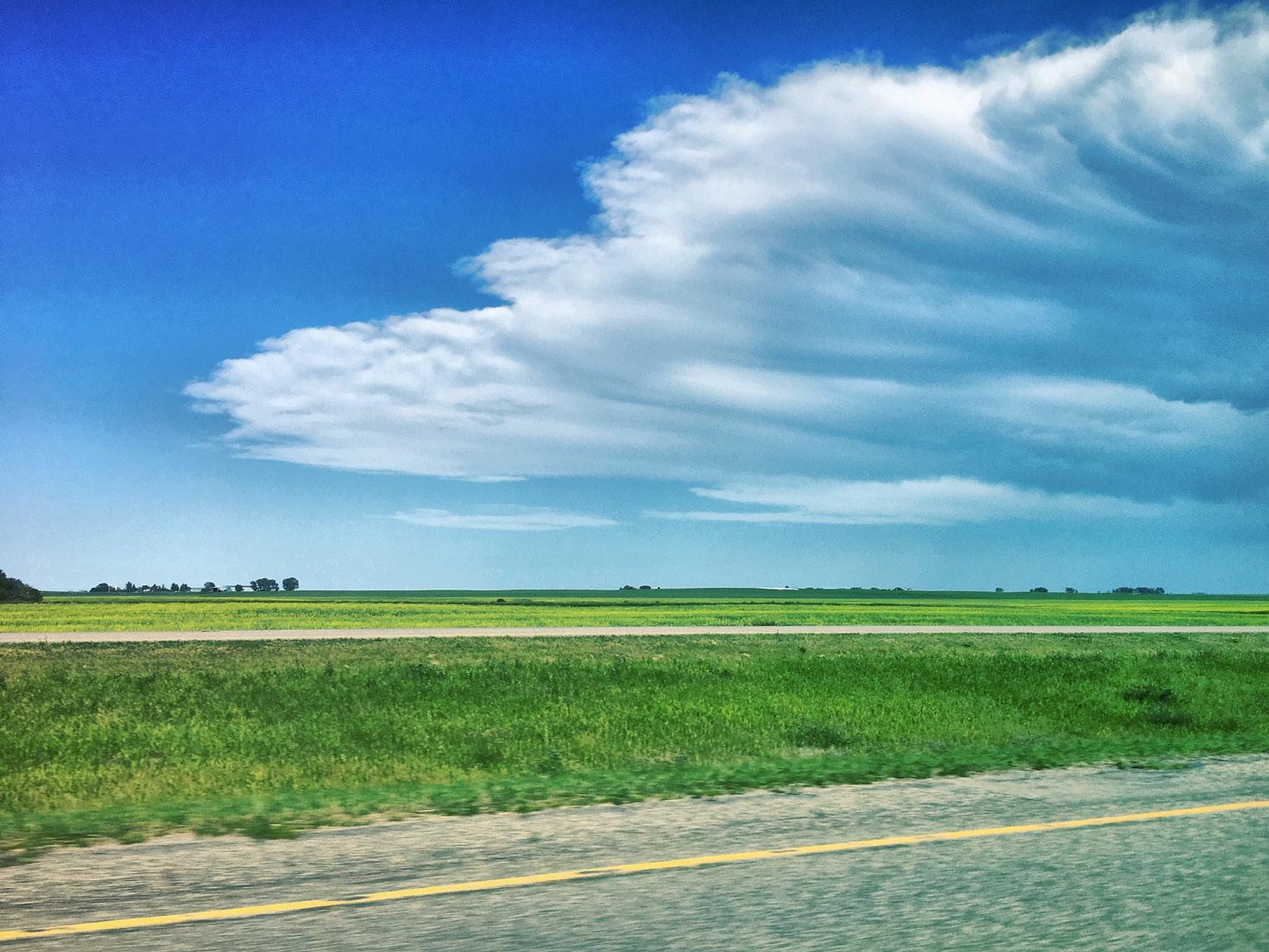
31 / in medias res VISUAL ART
Photography


Beyond the Wall by
MEERAH
Chalk pastel
on paper
I view the horizon as a wall that limits what I want to do in life. As someone who struggles with mental health, I can see where I want to be but have no means of moving forward. “Beyond the Wall” is a visual representation of that feeling.
Regular pen lines make it simple to capture the beauty of nature and I adore using them to create 2D landscapes. My piece “Horizon” is created with black ink on paper. It depicts a scene through a pupil, making the viewer part of the piece. I used a combination of line weight and texture to capture the feeling of vastness and movement of the landscape. The eye of the viewer is drawn to the horizon line, creating a sense of depth and perspective. Inspired by the scenes I have witnessed in my travels, I hope to capture the feeling of these landscapes and share them with others.
SHAHANE
Sketch pens on paper
“horizon” / 32 VISUAL ART
Horizon by
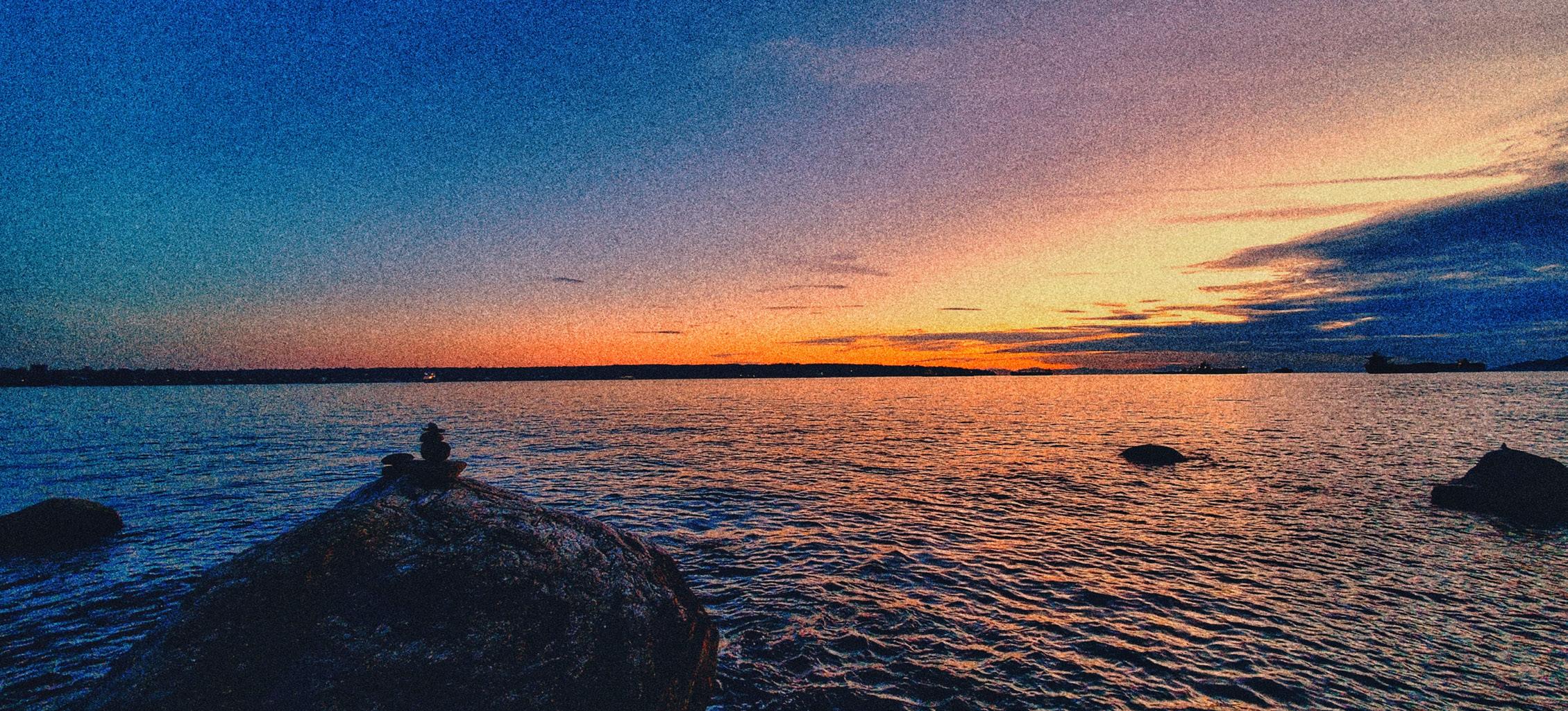
Beyond by KYUNGSOO RYU
Photography, taken by Galaxy 10e, edited on Snapseed
“Beyond” is named after the song called “Beyond the Sea.” This photo captures the moment of a scenic sunset view at Stanley Park.
The Painting
Robin Larocque
They write stories about people like me now
In their second act, they say
As if our lives before this time didn’t matter Because we were not famous or big or loud Because we spent all that time stifling our torments
Forty is when it all begins, they say
This is when we can shed our baggage
As if our baggage is not what brought us here
They tell us to discard it now, like trash we’ve finished with Loudly let it go to free our hands for new work
I am supposed to feel free
The wind over my shoulders, the air through my hair
I am supposed to close my eyes when I look towards the moon
To breathe deeply, as if this is the first breath I’ve ever really drawn and all the breaths I’ve drawn before were not practice for this moment
Impossible woman, they tell me
Reframe your desirability, they whisper
But they don’t know, I am wife I am mother I am soul
I am in my first act
My only story, with one end and only one beginning
33 / in medias res POETRY
Airplanes
Nolan Long
When I drive out to the airport
I’ll sit down on the apron And watch planes break through the clouds. I’ll count down with each and every one Until I see yours emerge in the distance.
I’ll fall into a long and euphoric sleep When that Dreamliner comes into view.
I’ll wonder what you’re seeing and What you’re thinking As the city grows beneath youThe sky falling behind you.
And as the plane falls closer to me, It’ll remind me of when I flew to you last Spring. Breaking through the purple sky.
For once, you won’t be in the distance. Though now you’re on the horizon, Then you’ll be in my arms.

Discernment
Graham Wall
Two quiet balsam trees rest in contradiction. Chlorotic and bright, the colours create friction —especially the leaves. The qualia of sight laughs at prediction.
Light speaks Greek, and dark, Hebrew— the language of chimes. But before I knew, the sound was not meek, for the crow had climbed; her judgment would imbue.
* Previously published on the author’s blog.
“horizon” / 34 POETRY
We asked you to paint your horizons...

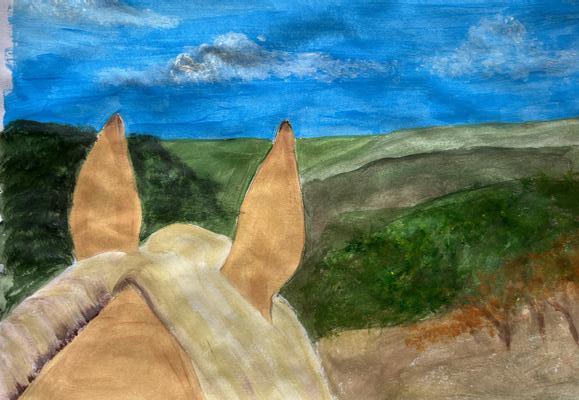
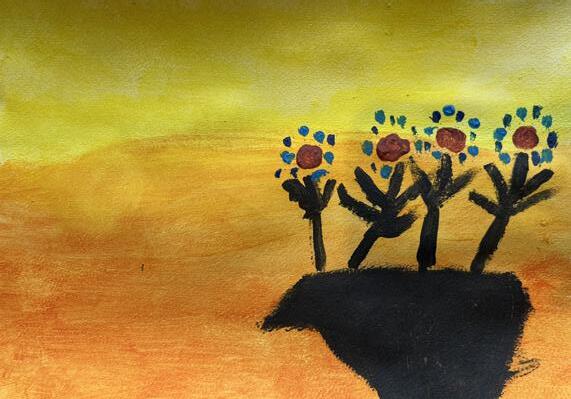
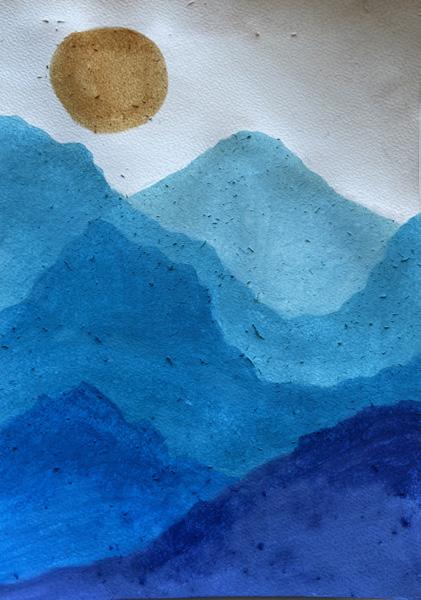

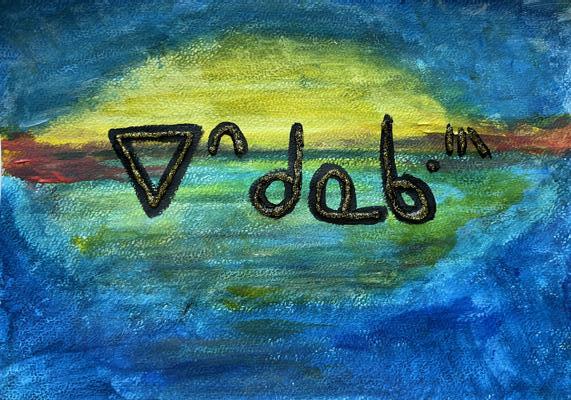

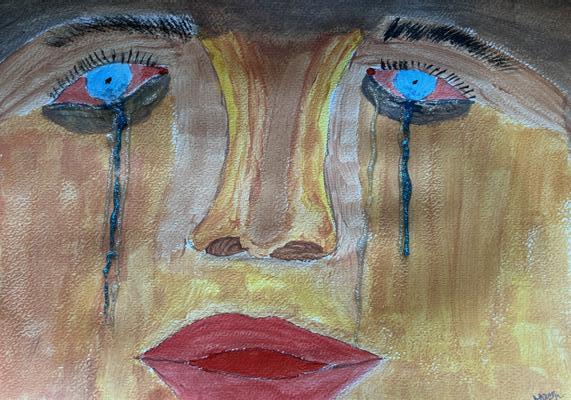
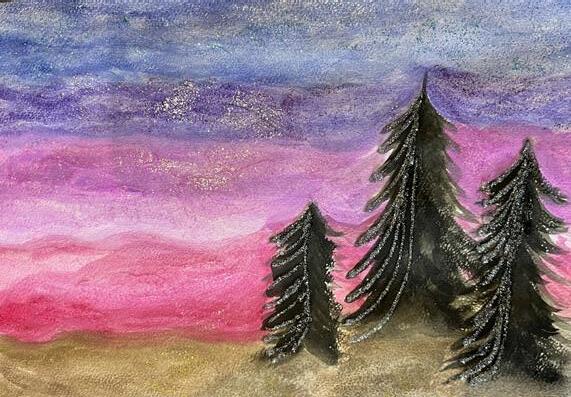

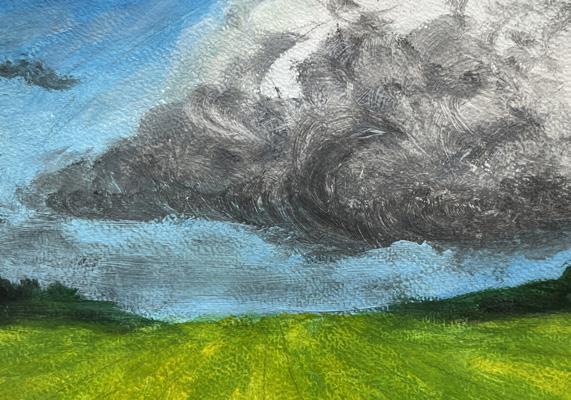

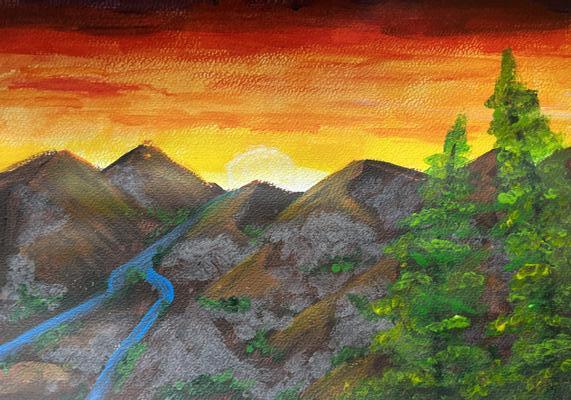

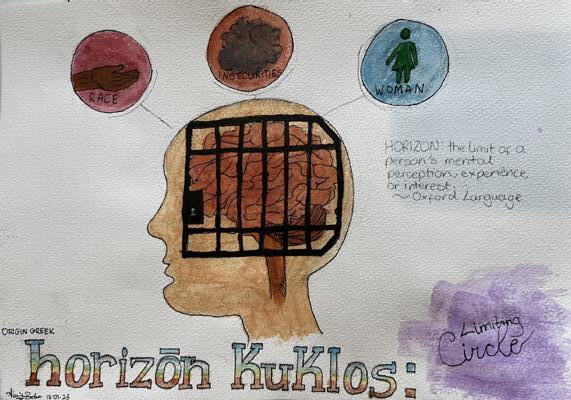

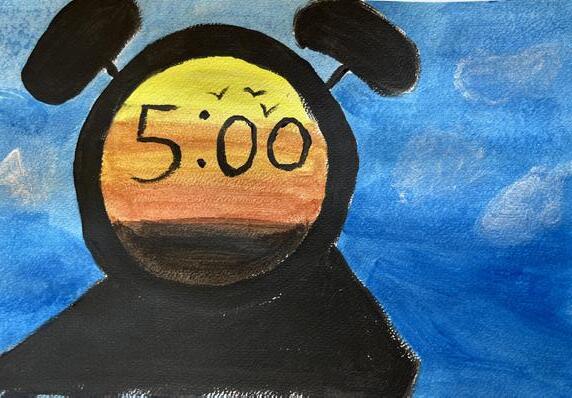
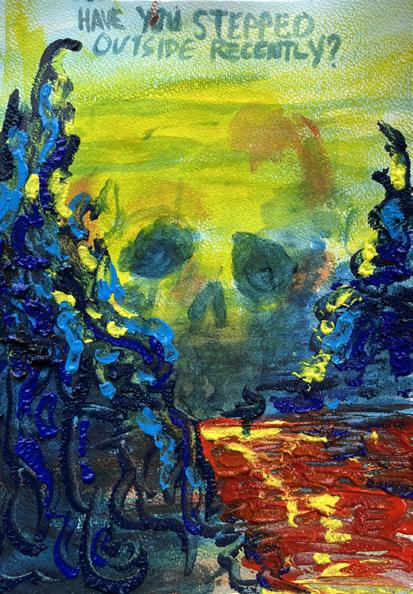
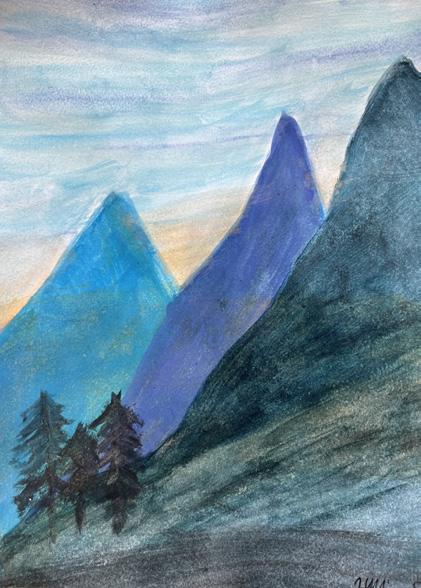

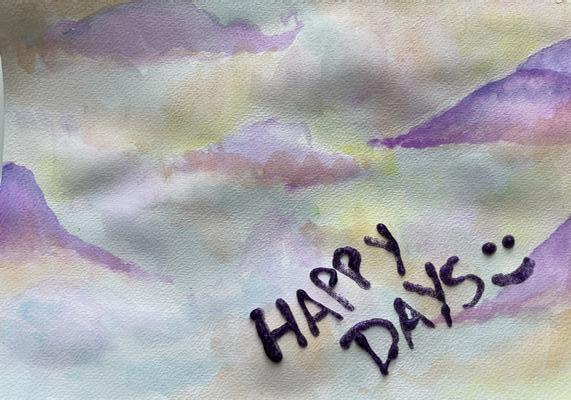
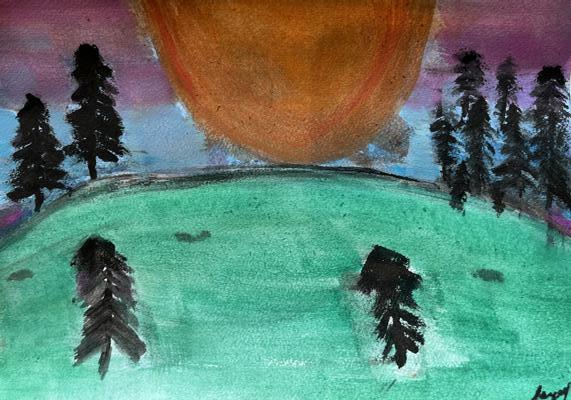
On January 13, 2023, in medias res hosted a come-and-go art event in the STM student lounge, resulting in these beautiful paintings. Thank you to everyone who came and participated!
35 / in medias res VISUAL ART
“A Saskatchewan Landscape”
Abena Amankwah-Poku (she/her) is a first-year student in the College of Arts and Science looking to major in Regional and Urban Planning. Abena enjoys being outside in nature, drawing, reading fantasy books, travelling and baking.
“finding horizons mine // the edge of my earth”
Ji Hyun Chan (she/her) is a first year drama student. She loves going to plays, writing tankas and other forms of poetry, and learning new things. As a mature student, she feels that she is trying to broaden her horizons, mentally and emotionally. It doesn’t matter where you are in life, she thinks you can always do better and go further. It may make us uncomfortable at times but there is something freeing about it.
“Home is Where the Sun Sets”
Robyn Claypool (she/her) is completing her one-year business certificate here at USask. In her free time, she likes to write poetry, go for walks to the river, and take trips to Vancouver to see her friends and family. She describes her work as story driven, steeped in imagery, and inspired by the ways in which she lives in this world. She likes to write about the passage of time and how things change. Her poem, “Home is Where the Sun Sets,” relates to the horizons motif in the literal sense of the nature of sunsets and the way change can bring new horizons while you also look back on what you miss—what you’ve left behind.
“The View”
Kurt Chavez was born in the Philippines and moved to Canada when they were six, bringing with them a tendency to doodle. Like many others, they found themself doodling on the margins of homework, assignments, and tests. This soon grew to become a hobby, something they wanted to continue pursuing and improving. This probably comes from that feeling when one is unsatisfied with one’s finished work, knowing that they can do better. Kurt continues to try and improve their art and their skills. While they prefer using pen and ink, they understand the importance of trying out different mediums to grow their techniques and knowledge, so they’ve been dabbling with painting recently.
“Beyond the Horizon” & “Out into the Distance”
Ann Brooymans-Donald has lived and taught art in Saskatoon for over 20 years. She enjoys captivating images in her environment. Her connections with nature is the inspiration for her use of the elements and principles of design. Her work celebrates the prairies. Ann has been in numerous exhibitions throughout Canada and Holland. She has been teaching art in galleries, museums, high schools, elementary schools and universities. Ann holds degrees related to creating and teaching art from Mount Alison University, Concordia University, University of Western, York University and an Art Academy in Enschede, Holland. Ann Donald has recently retired from teaching art and graphic design at Holy Cross High School in Saskatoon. She was the first Advanced Placement Art and Design teacher in Saskatoon. She has collaborated with many art teachers and artists on numerous projects. She was awarded Canadian Art Educator of the Year (Grades 9 to 12) in 2021 by the Canadian Society for Education Through Art. She now works as an artist at Studio on 20th and Clayworks. She can be reached at anndonaldart@gmail.com.
“Rigby”
Becca Dunkle (she/her) is currently in her second year of university, majoring in English and minoring in history. She has always loved writing in her spare time, which she supposes suits both her degree and her publication in this magazine. Becca’s poem is an ode to her childhood cat, who passed away right before Christmas. This poem emphasizes her sorrows, alongside the hope she possesses to meet him again in the “horizon”—which in this poem, is the next life, whatever that may be.
“Dreamers”
Sohila Elgedawi (she/her) is currently in her second year of study pursuing a Bachelor of Science. In her free time, she loves hanging out with her friends, exploring new cafes in the city and of course writing. She would describe her work in general as emotional, every phrase exudes a feeling that fall in the realms of longing for love, acceptance, or happiness. For the theme of horizon she chose to interpret it as future, but in our generation when we think of the future it is often bleak. She attempts to capture that feeling of hopelessness in ‘Dreamers’.
“14/02”
Erin Gilbert (she/her) is pursuing a double degree in Political Studies and French, with one year remaining. In her free time, she enjoys spending time outdoors and connecting with nature as well as observing our social world—she considers herself a plant lover and a people watcher. Her work is often a mix of visual and literary arts, genres, and mediums in an attempt to examine the juxtaposition and complementarity of natural elements to human-created constructions.
“A Letter to My Anecdotal Self” & “At the Trial of God, You Will Meet Your Body”
hoiyan (they/she/he) is a second-year Education student at USask. Having a weak attention to detail and even weaker sense of routine, hoiyan thrives off disorder and whimsicality. They could enjoy adding onto their ever growing pile of unfinished art and writing one day, then playing video games or guitar or with their pets—or all three simultaneously—the next. “At The Trial of God, You Will Meet Your Body” is a poem inspired by the interpretation of ‘horizon’ as a metaphor for a life journey or scope of an uncertain future. “A Letter to My Anecdotal Self” is an odd piece inspired by mundane happenings from the past, present, and perhaps even future, in the form of seemingly simple anecdotes.
“Hay Bales”
Linda Huard (she/her) is an alumna of STM and USask, having finished her BA(Hon) in English in 2016. Linda works for the College and serves as the staff mentor for in medias res. She is grateful to remain here on campus where she still feels right “in the middle of things.” She loves to have coffee dates with friends, discussing life, literature, and art.
“Let Me Live”
Rachel Janzen
“The Cold Welcomed Me and I Embraced It”
Sesan Johnson (he/him) is in the second year of his master’s degree in Interdisciplinary Graduate Studies. He is an award wining researcher whose research interests include the history of medicine, public health, diseases, and African diaspora health. He has published articles and has presented his research at numerous academic conferences around the world.
“horizon” / 36 CONTRIBUTORS
CONTRIBUTORS
He loves to read and write poems and to engage in public discourse via radio, TV and social media. Sesan’s poem expresses and juxtaposes the world views of his country and Canada. It also refigures his lived experiences in Saskatoon, especially his experiences with cold.
“Choose to Heal, Choose to Change” & “Dream Beyond the Moon and Stars”
Asma Kamel is a first-year graduate student at the College of Dentistry, University of Saskatchewan. She is a nature and mental health advocate who believes that nature is the best therapist. Her philosophy is that the deeper you delve into nature, the more your spirit is enlightened and hidden pieces of yourself are revealed. Asma is a nature photographer who sees that the beauty of nature is something that can never be replicated or replaced, yet the best way to truly appreciate its beauty is through photography. She believes that each shot conveys a message from nature.
“Choose to heal, choose to change”, and “Dream Beyond the Moon and Stars” are two nature-inspired messages she wants to share with us.
Instagram: @asma7fadl.
“An Ode to Borscht”
Marta Krueger is a multi-medium artist, but her primary art practices are painting and sculpture. Marta has spent the past five years working towards her Bachelor of Fine Arts Honours degree, with a minor in Psychology. She will be graduating this spring of 2023. In the near future, Marta plans to continue exploring her creativity and her education in Fine Arts and Art History. Marta also has interest in studying the connections between visual arts, folklore, and cultural traditions. It is through her connections to her Ukrainian heritage and traditions that Marta draws inspiration for making her art.
“The Painting”
Robin Larocque (she/her) is a master’s student in the Religion and Culture program at the U of S. Her writing spans from the academic to the creative and her observations range from humorous insights into the deeply mundane to the darker side of life (and death). With her writing, Robin seeks to stretch the boundaries of comfortable conversation. Horizons, the theme for this year’s issue, evokes a sense of new beginnings. As a mature student, Robin often finds her journey framed as a new
start. “The Painting” challenges this notion.
“Airplanes”
Nolan Long (he/him) is a second year Political Studies major, minoring in Religion and Culture at the University of Saskatchewan. Apart from school, he devotes much of his time to writing both poetry and political essays, both of which can be found online. His work in this volume, entitled “Airplanes,” is a short poem describing the feeling of waiting for an approaching event. It deals with the issue’s theme in the sense that we often wait for coming events by picturing them “on the horizon.”
“In the Partial Shade”
Jocelyn May (they/them) is a first year studio art major. They spend their spare time drawing, reading, writing, and as of late, playing Minecraft. In their written work, Jocelyn likes to express themes of intimacy and explore the human condition. They would describe their writing style as being a string of rambling thoughts rearranged into something coherent. Jocelyn’s poem, “In the Partial Shade” relates to horizons with its pastoral-like setting and using tone to express an anticipated feeling that good things will come.
“Pro et Contra”
Dr. Caroline Arbuckle Macleod (she/ her) is Assistant Professor of Classical and Near Eastern Archaeology at St Thomas More College. She studies ancient Egyptian wooden coffins, the contribution of women to the field of archaeology, and the portrayal of archaeology in digital games. She loves to travel, visit museums, cook, and play video games with her husband and son.
“Beyond the Wall” & “Reach”
MEERAH is a Saskatoon-based graphic designer and artist who explores digital and traditional mediums. Common themes in her art include mental health and integration. She is a third-year student at the University of Saskatchewan pursuing a B.F.A. Honours in Studio Art. She is also the President of the Visual Arts Students’ Union, a Board Director at PAVED Arts, and the Design Director for Youth Helping Youth.
“Before the Night”
Joseph Medernach is an undergraduate Computer Science student at the University of Saskatchewan
“whatever it was it was and it is not it now” & “your mother and i have the same hands”
Greg Orrē [pronounced “greg-ory”] (he/ him) explores connections between nature, art, and spirit through songwriting, poetry, painting, and video. In 2020, the Saskatoonbased multidisciplinary queer artist began sharing his project, I Am In It, with an album and a handmade poetry collection. Published by Labyrinth Anthologies and in medias res, his writing often questions how clearly he is viewing his current horizon.
Greg Orrē is working on two new poetry books, and will release his sophomore album, I Am In It, Vol. 2, in late 2023. Greg completed a BA (2011) and a BEd (2013) at the U of S.
“Peace on the Horizon”
Lara Paul is a local Indigenous educator with personal interests in the visual arts. After years of work simultaneously poured into motherhood and university studies, she now finds that practicing art and enjoying trips to the lake provide the self-care needed to heal and prosper with balance in the modern age.
“Long Summer Drives Across the Prairies”
Rida Pervaiz is a 4th-year pharmacy student at the University of Saskatchewan. Her passion for photography runs in her blood as she has learned it all from her father. She enjoys capturing landscape photography and has a soft spot for Urdu poetry. People often describe Saskatchewan as flat farmland, but Rida believes that people have not yet taken the time to discover the beautiful landscapes that the prairies have to offer.
“Before the Storm”
Narges Porsandekhial (she/her) is an Iranian multidisciplinary artist, studying her MFA degree at the University of Saskatchewan. She primarily works in installation, socially engaged practices, public art, and text-based work. Her work deals with the repetition of daily life activities, while focusing on conceptual and social practices, mental health issues, and institutional critique from time to time. She believes that art is not a luxurious object for a specific group of people and it’s the element of storytelling that invites a broad audience to the work.
Instagram: @narrporr Website: nargesporsande.com
37 / in medias res
“Polar Bear”
Kas Rea (she/her) is a Saskatoon-based artist who primarily works in chalk pastels. Her work focuses on themes of nature, specifically the importance of animal and plant preservation in Canada and Bolivia, where she has family connections. Rea recently completed her BFA from the University of Saskatchewan, where she was also the 292 Gallery curator and on the board of the Visual Arts Students Union. Rea also completed her Certificate of Art and Design and attended Kenderdine Campus at Emma Lake. She currently works full-time at Remai Modern as the Community Programs Assistant. Instagram: @kasreavisualarts Website: www.kasrea.com
“A Step Closer to the Undefined” Mariana Campos Rivera is from Mexico City and moved to Saskatchewan in 2019. She enjoys swimming, reading short stories, and working towards the fall of the patriarchy. This is her first published nonfiction piece. She is currently a Research Assistant at the University of Saskatchewan working on Climate Communication and Education. “A Step Closer to the Undefined” is a short reflection on how our experiences become a blurry but foundational part of our identities.
“Beyond”
Kyungsoo Ryu (she/her) is a second year Accounting student in Edwards at the University of Saskatchewan. She also works as a Graphic designer at Visual Arts Students Union (VASU), Graphic design coordinator at Pre-Law Student Society (PLSS) and more! Her passion has always been in arts, graphic design, and photography. Currently, she is into film cameras and wants to learn about film development.
Instagram @rks.zip
“January Hands”
Bailey Schaan (she/her) is a booklover, creative, and third-year honours English student at USask, with a minor in history. Bailey’s work seeks to bear witness to the moments of in-betweenness, tension, and mundanity inherent to life and reflected within nature. In her poem “January Hands,” Bailey explores how one can simultaneously be content with the darkness of winter while longing for light of new seasons. It is in within this tension where she strives to campout for the remainder
of the cold months. Besides writing, Bailey adores autumn, tea, rearranging her bookshelves, and spending time outdoors with the ones she loves.
“Horizon”
Shahane is a studio art major at USask. They have always been passionate about the arts and have been exploring various forms of creative expression since childhood. Drawing, painting, and sculpture are their true loves, and they constantly experiment with different mediums. In their free time, Shahane also enjoys photography and digital art. They hope to use their education and experience to create meaningful and impactful pieces of art that celebrate the beauty of nature and human experience.
“(seconds for st romero)”
Mike Sluchinski is an alumnus and currently has an undeclared major. He writes bad poetry and does construction and renos on the side. His poem, “(seconds for st romero),” addresses a very short time period, which might also be considered a horizon. In Romero’s case, it reflects a transformation of spirit and body, travelling between worlds—the separation of the physical and spiritual realms—within a terrible and tragic moment, sadly, his death.
“Dream of Tomorrow”
Liam Timmerman is a first year business student and a Metis transgender man. He is from Melville Saskatchewan and is in pursuit of not only a Bachelor of Commerce degree, but exploring Metis culture in the city of Saskatoon. He has a passion for exploring gender expression and mental health struggles through his artwork. Liam currently resides on campus and invests his time exploring all the opportunities Saskatoon has to offer when he isn’t studying. When he is not spending time with family and friends, you can find him sharing his artwork on Instagram @_asherlux_.
“Discernment” & “Transience”
Graham Wall (he/him) earned a B.A. in Sociology with a minor in Philosophy from the University of Saskatchewan in 2017. When he’s not reading theoretical books, you can catch him making quirky beats for his electronic music project, Silent Music. Graham has worked with words on a variety of topics, including the arts, marketing, and mental health. “Discernment” and “Transience” approach this issue’s theme psychologically. The former explores the
valence and limitations of processing contradictory information, while the latter discusses cognitive faculties by means of nature symbols.
“Winter in Saskatchewan”
Cynthia Wallace (she/her) is an Associate Professor and the Department Head of English at St. Thomas More College. She likes to read, write, cuddle with her kids, bake and make things, and listen to peoples’ stories in her free time. Her poem describes a winter morning when the prairie sky reminded her that winter doesn’t last forever: it was a reminder that she really needed that day, for all sorts of reasons.
“Dangerously Below the Horizon”
Krista Wilde was born and raised in Saskatchewan, and this is her first published short story. She is currently an English student at the University of Saskatchewan. “Dangerously Below the Horizon” is a short story set in the early 20th century Canadian prairies about a settler boy’s life on the farm as he struggles to navigate relationships with his family.
“Pro et Contra”
Dr. Hannah Kirby Wood is a lecturer in the History Department at St. Thomas More College. When she’s not immersed in the Middle Ages, she enjoys exploring whatever city she’s living in (she’s lived in quite a few!), lovingly pestering her cat Heloise, and watching reruns of Parks and Rec. Her favourite book is Le Petit Prince, because it reminds her that the simplest things are the most beautiful.
“Once They Were Children”
Emily Zbaraschuk (she/her) is a secondyear student who is majoring in English and minoring in studio art. She is fascinated by the intersection of art and writing and has enjoyed working with in medias res as the layout and design editor. Her piece of creative nonfiction, “Once They Were Children,” considers the threshold between childhood and adulthood, asking why horizons shrink for the marginalized as they age. In her spare time, she crochets, tries new recipes, and forages for fun facts on Wikipedia.
“horizon” / 38 CONTRIBUTORS

My work necessitates spending a lot of time on Saskatchewan’s roads. Along with ample time for audiobooks and podcasts, a great benefit to travelling across the province is the picturesque view I’m often granted. “Hay Bales” is based on a photo I took on one of my drives. I felt compelled to pull over to capture the wistful clouds, autumnal tree line, and golden hay bales that remind me of my childhood home.
in medias res is a student-led liberal arts jornal at St. Thomas More College that aims to publish content to reflect the identities of the campus community, its complexities and diversities. Our mission is to be a forum for community expression that showcases the highquality work of artists in the University of Saskatchewan community.
Our title describes the experience of university life, in which we are always caught “in the middle of things.”
What are you thinking about? What worries you? What moves you? We want to hear the artistic voices that make up our community and help put their work out into the world.
Our office is located in room 158 of St. Thomas More College in Saskatoon, Saskatchewan. We acknowledge that we are on Treaty 6 Territory and the Homeland of the Métis. We pay our respect to the First Nations and Métis ancestors of this place and reaffirm our relationship with one another.
As part of their mission statement, St. Thomas More College says that “the work of our college is not an end in itself, but must find application for the good of humanity.” We ask all readers to consider how they benefit from settler institutions such as the university and how they can apply their learning not towards maintaining the status quo but instead towards change and meaningful reconciliation.
stmcollege.ca/imr
@inmediasresstm
Hay Bales by LINDA HUARD
Acrylic
* * *















 Reach by MEERAH
Reach by MEERAH






 by ASMA KAMEL
by ASMA KAMEL





























